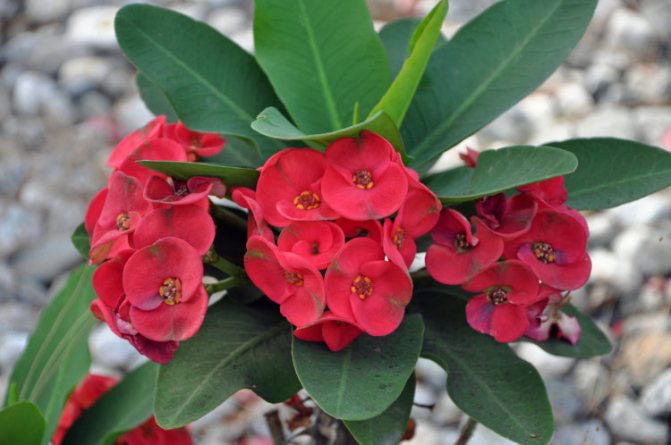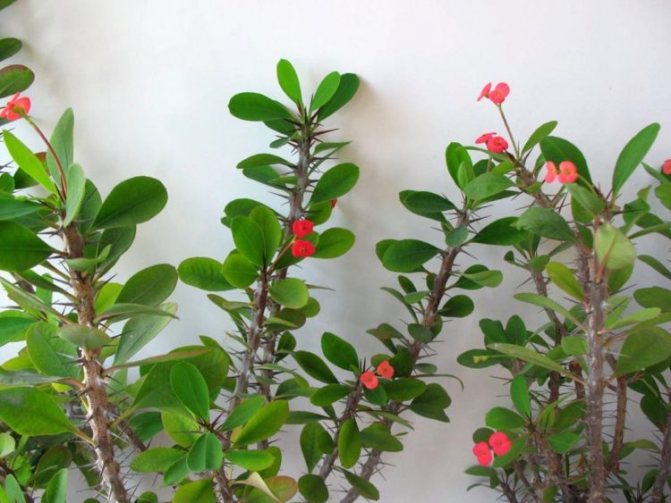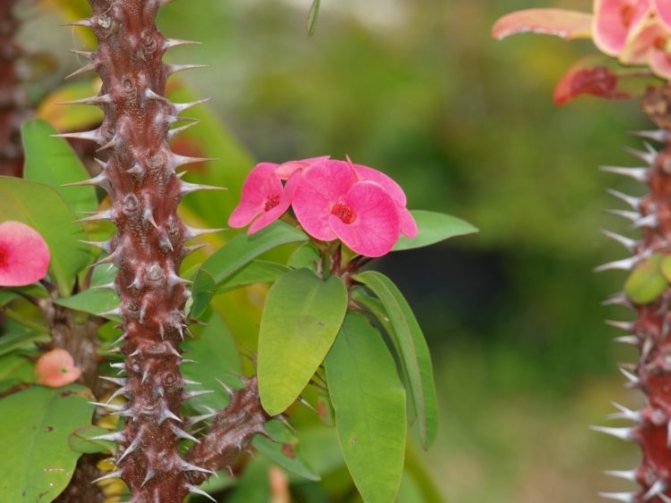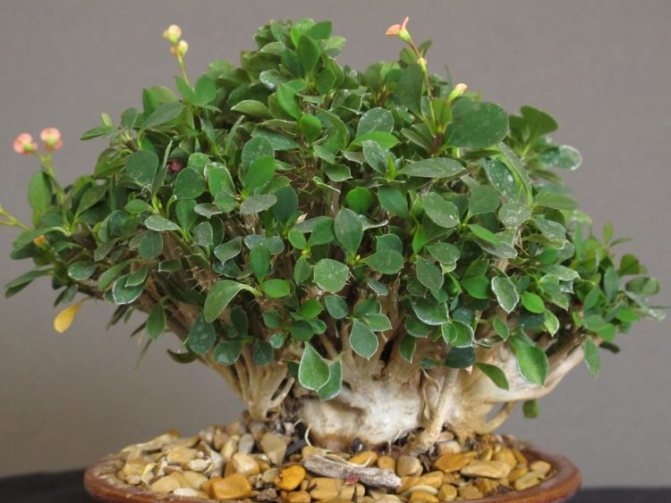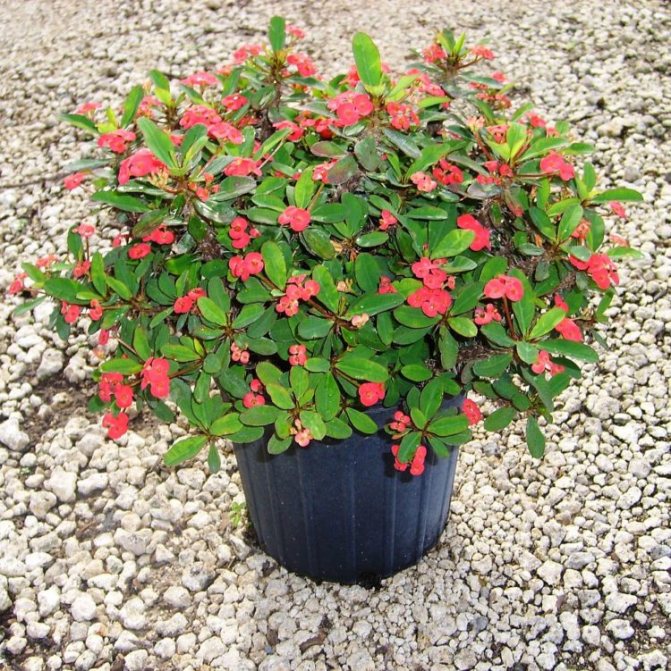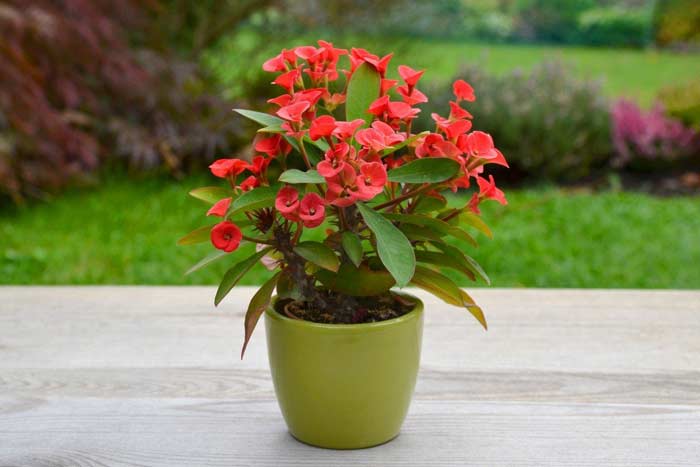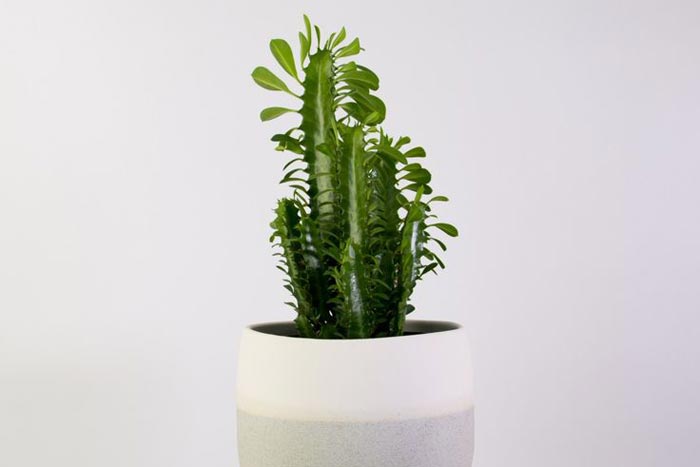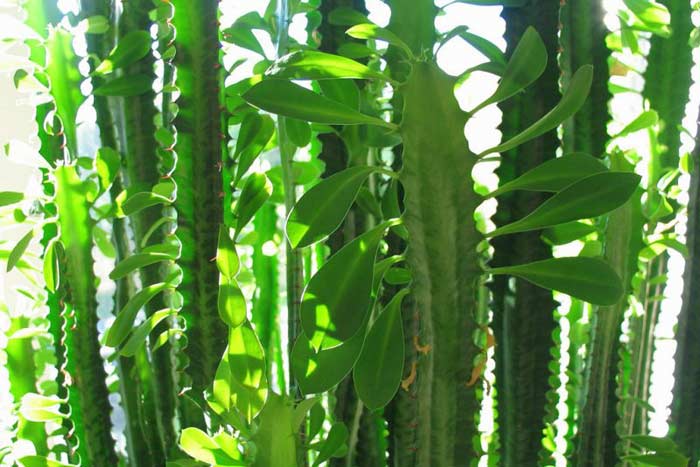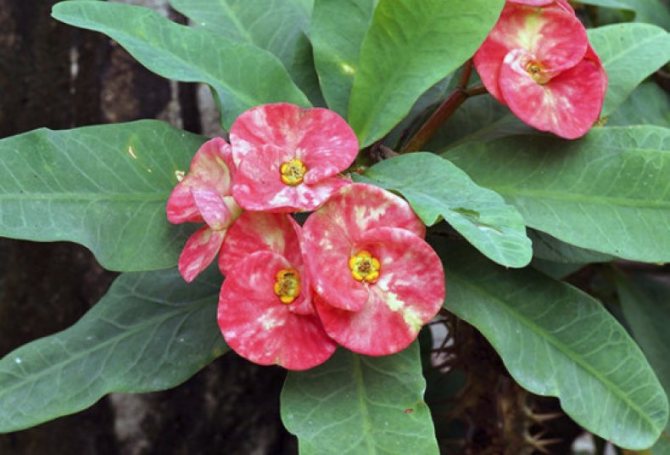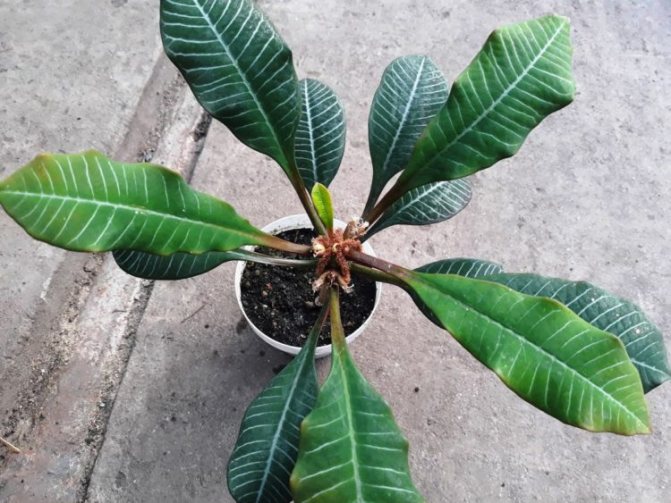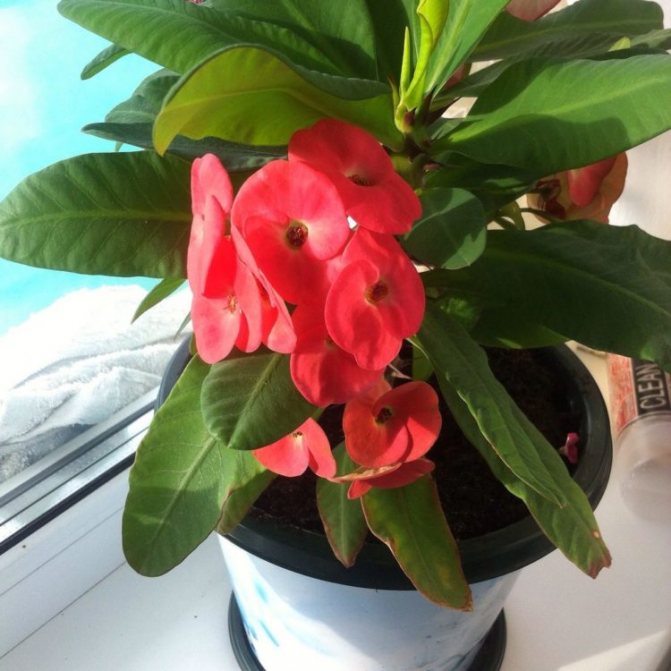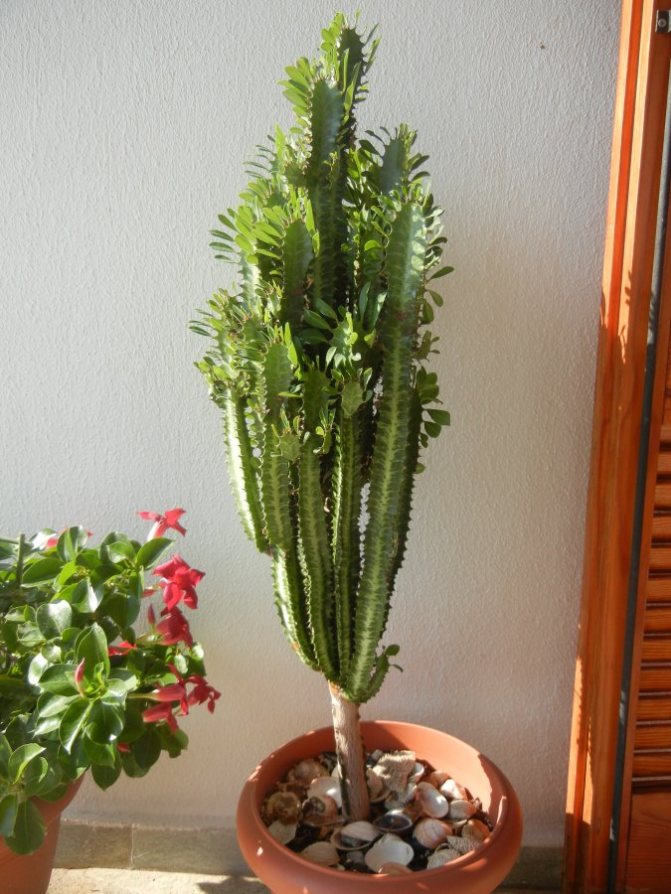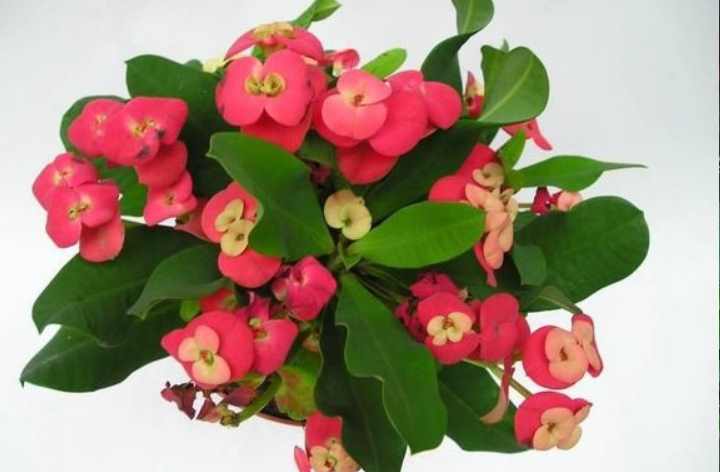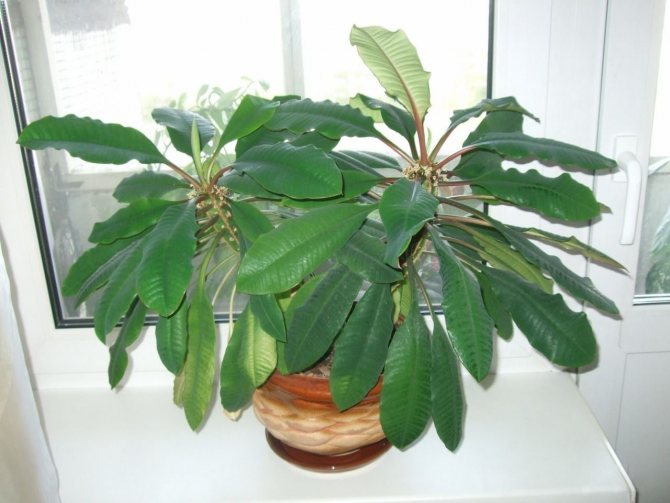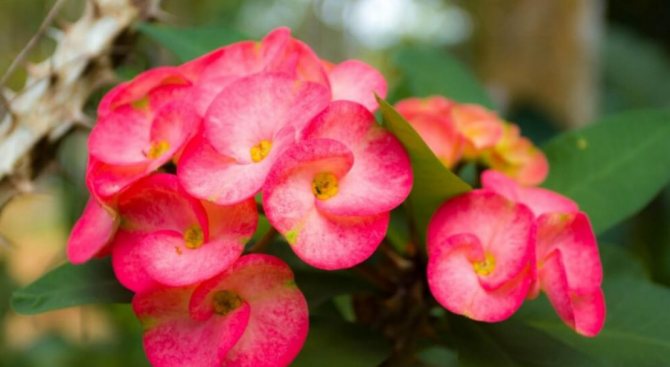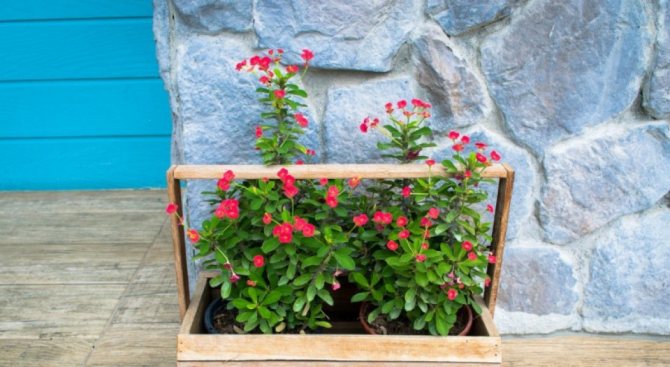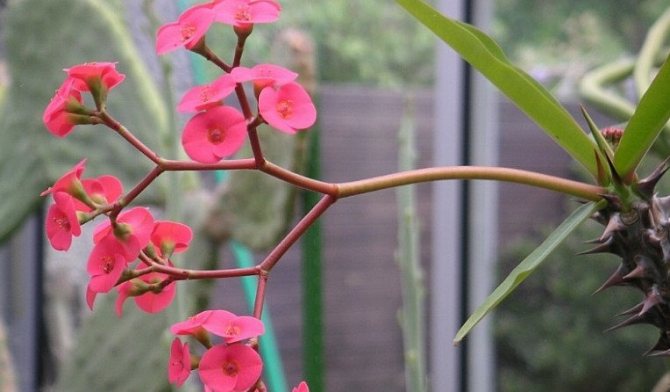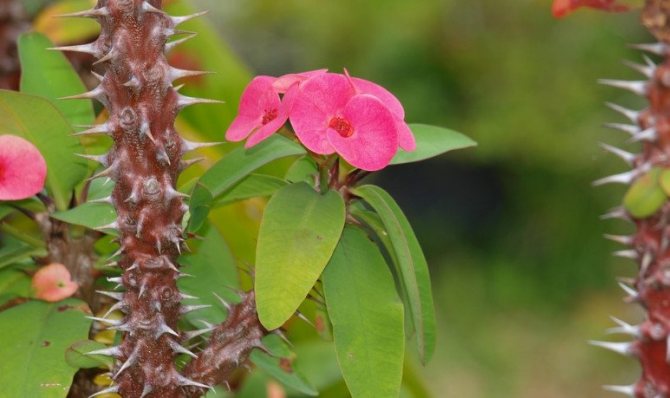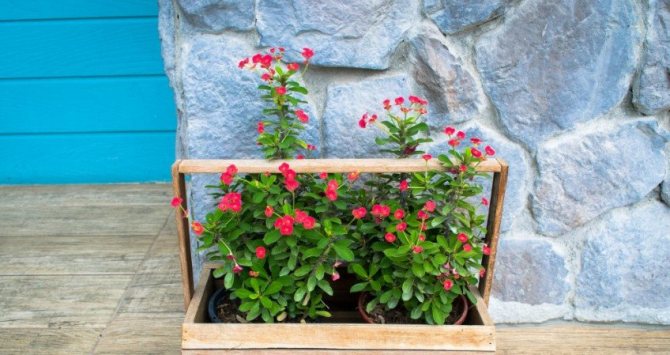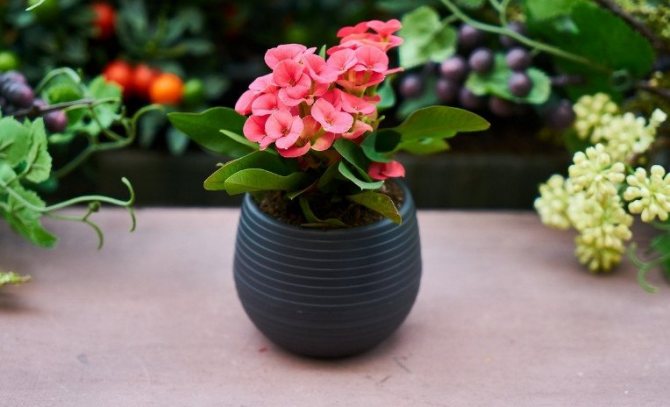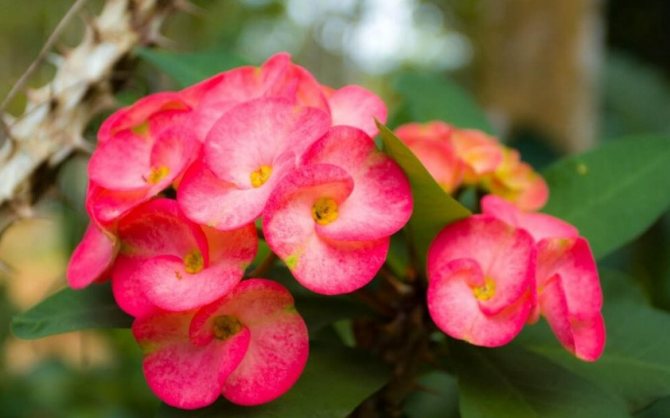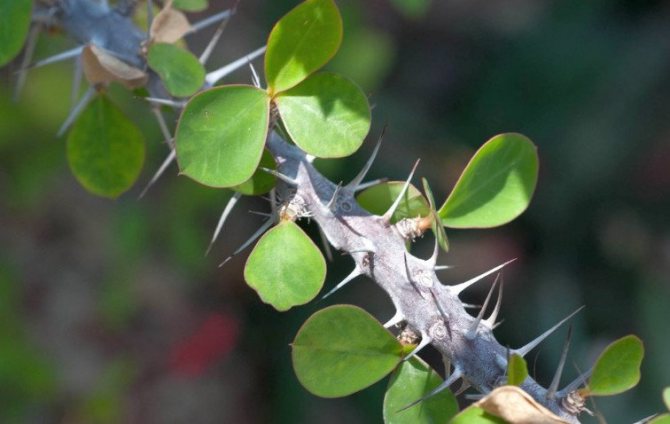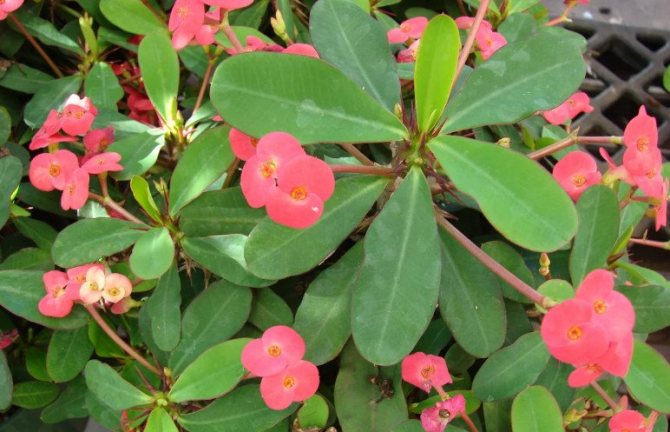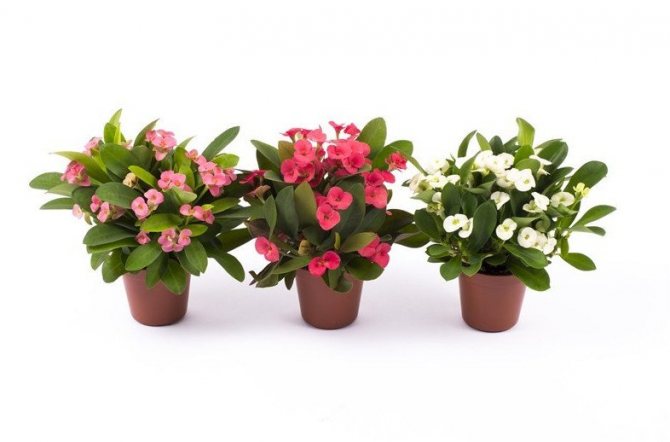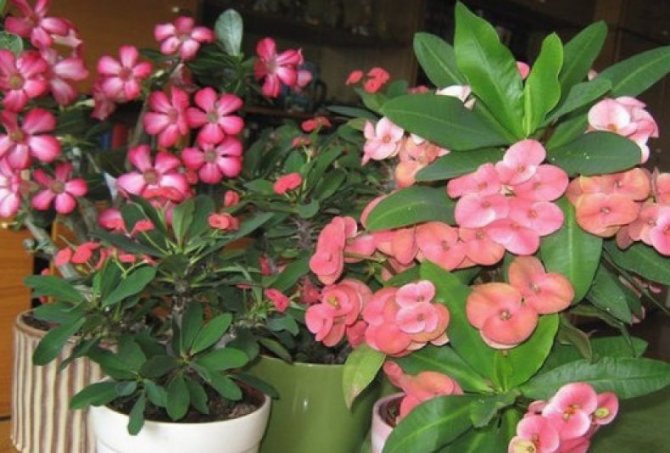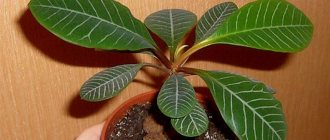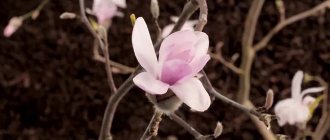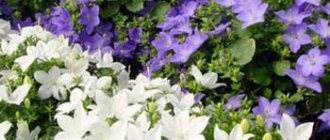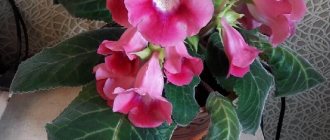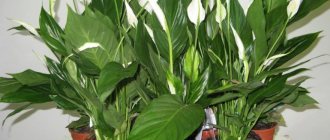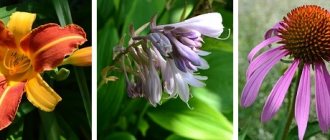.
Modern housewives love to grow different flowers at home. Often they do it thoughtlessly: they choose plants, focusing only on their appearance, or accept them as a gift from friends, take care of them incorrectly, or put them in any free space. This approach cannot be called good, since each flower has its own characteristics. Their ignorance and carelessness of the hostess can harm the whole family.
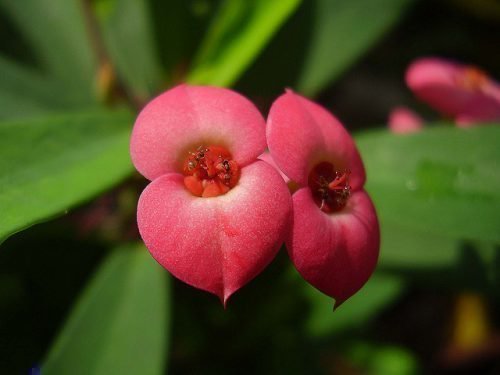
Euphorbia has an attractive appearance
Decorating your windowsill
When you bring a thorny twig home, your family may be disappointed with this choice. Nondescript, brown, with strong thorns, it does not cause much sympathy. But wait. Soon the plant will release leaves and become much more elegant. And it reaches its maximum decorativeness when the time of flowering comes. Rounded branches, covered with delicate foliage, and bright red, blazing flowers ... All this makes it surprisingly attractive.
Florists can be roughly divided into those who are engaged in delicate, tropical plants, and who prefer to grow the most unpretentious, but decorative species. If you are one of the latter, then succulents are the ideal choice for you. Mille euphorbia has also proven itself quite well. Caring for it at home is not difficult at all. This is an unpretentious plant that is grown separately or in a composition. A home alpine slide is fine.
The plant also looks good in a single planting. But if you put together and thoughtfully place 10-15 pots, then at the time of flowering this corner will be simply irresistible. If you have the time and desire, be sure to try yourself as a landscape designer.
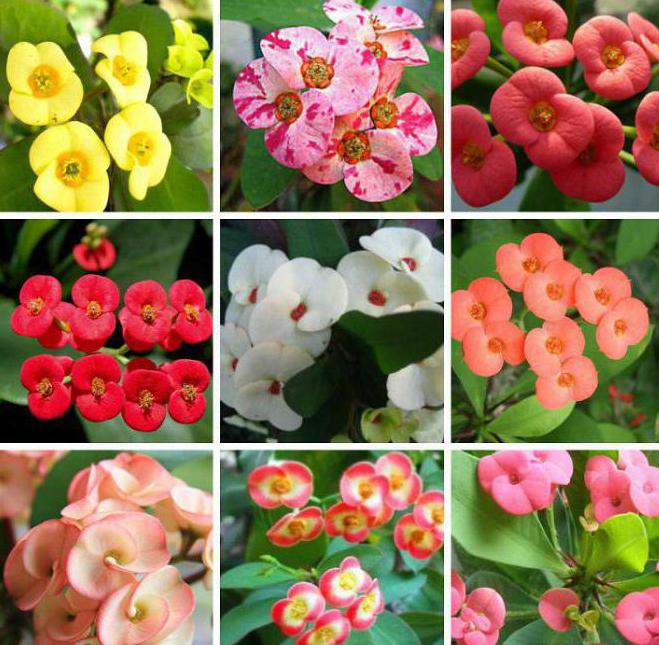

Photo
And this is how a well-groomed plant looks in the photo:
Temperature
This is one of the most important factors. It is with maintaining the temperature regime that home care is associated. Euphorbia Mila does not like strong daily fluctuations. With stove heating in the morning it can be +16, and in the evening +22 degrees. In this case, it can be assumed that growth and development will be suspended. The plant will not die, but will go into hibernation until conditions improve.
It is a very thermophilic variety of euphorbia. In summer, the air temperature should reach +25 degrees. Therefore, you can take the pot out to a sunny and warm veranda. With the onset of cold weather, a decrease in indicators by 10 degrees is quite acceptable. Low air temperature is detrimental to plants, since its root system is supercooled, and it can die.
Providing good sunlight is another important point that is decisive when it comes to optimal care. Euphorbia Mila cannot stand shade and darkness, so you should carefully choose a place to grow this crop. It is one of the few plants that thrives in direct sunlight. The more light, the better your green pet will grow.
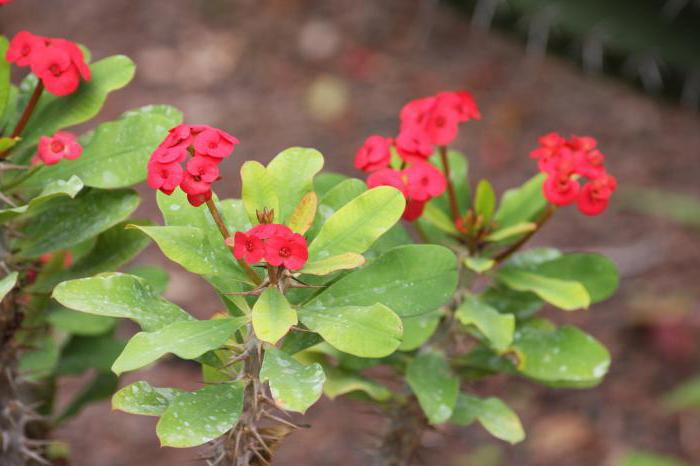

Origin name
Where it came from is not known for certain. Some of the florists believe that this is a word form from "cute". However, at first glance, Mil's spurge is very difficult to call such. Of course, this is an ornamental and rather beautiful plant. But the long thorns give it a dangerous look. However, this stops few people. The plant attracts with its brightness and unpretentiousness.Mille spurge appears more often than others in apartments, houses or greenhouses.
In the special literature, you can find another name - euphorbia. It is under him that it appears in various reference books. Another name for the culture is the brilliant euphorbia. The people call it the crown of thorns.
Watering
And we continue to talk about what needs to be done to grow the beautiful euphorbia Mil. Home care involves a special watering and humidification regime. Do not forget that the plant came to us from arid Mexico. Therefore, this species is drought-resistant. To this he was accustomed to living in the desert. That is, hydration is required no more than twice a week. In this case, it is very important to wait for the soil to dry out.
In winter, the plant rests, so watering must be reduced. A novice gardener can be advised to water the flower when the earthen ball is completely dry. Of course, the roots should not be allowed to dry out.
And yet this plant is much better to dry out than to overflow. Watering often and abundantly will cause root rot. The pet will die without immediate rehabilitation. At the same time, the complete drying of the earthen coma will lead to yellowing and leaf fall.
Separately, I would like to say about air humidification and spraying. Euphorbia Mila, whose photo is given in the article, grows and develops well in a dry room. This is a plus for city apartment owners. However, the room occasionally needs to be ventilated. This is good for both you and your plant. In winter, keep the pot away from batteries. But spraying milkweed is unacceptable. Be very careful when watering. Drops of liquid should not fall on the leaves. In most cases, this provokes the development of a fungal infection.
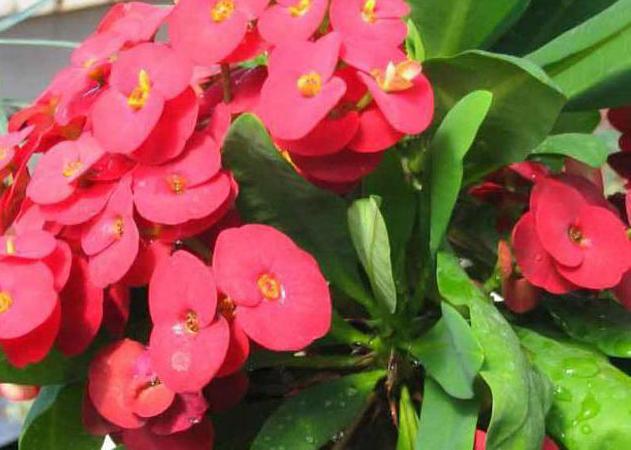

Can it be outdoors?
Reference. Euphorbia Mila is a very light-loving and thermophilic plant. It requires a lot of sunlight.
This flower comes from a warm country - Mexico. Given these features, we can conclude that in Europe and Russia, euphorbia is grown only indoors, that is, at home. These can be various gardens, greenhouses, offices and window sills of apartments, private houses.
To grow euphorbia, it is important to know about the methods of its reproduction and the nuances of rooting in the open field and at home. Read more about this here.
Reproduction
Euphorbia Mila takes root quite easily. Therefore, if your friends have such a plant, then it will not be difficult to plant a layer for you. Euphorbia usually reproduces in three ways:
- cuttings;
- seeds;
- dividing the bush.
The easiest way is to plant a stalk, so let's look at this procedure in the most careful way. The first thing that is required is to find an adult, strong plant without signs of fungal and other diseases.
- Find shoots that can be removed without harming the overall health of the plant. The top with several pairs of leaves is cut off from them. The length should be about 12cm.
- Prepare some warm water in advance to thoroughly rinse off the milky juice.
- All cuts are sprinkled with charcoal. Any stimulant can be used that will take root faster. For example, it could be Kornevin.
- It is not recommended to immediately plant them in the ground. The stalk should be in an empty glass for several days. This is important as the cut should dry out slightly.
- The cuttings are planted in a soil specially prepared for them.
- They need to be watered abundantly and covered with plastic wrap to create a greenhouse effect.
- For rooting, it is required to keep the cuttings in a bright place at a temperature not lower than +20 degrees.
Usually after two weeks, you can already expect the appearance of roots. It is best to carry out propagation by cuttings in the spring.
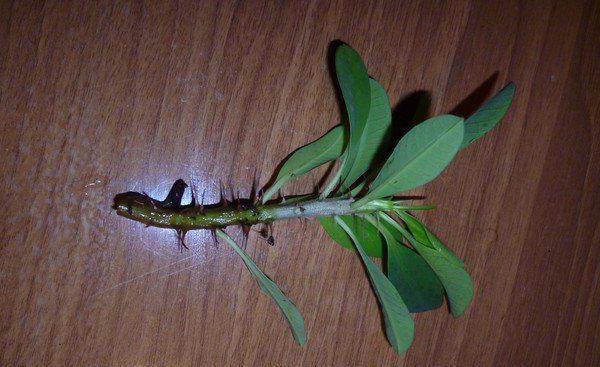

Guest from the desert
Indeed, Mila spurge grows freely in Magadan and Mexico, from where it was introduced. Despite the long acclimatization, he is still very picky about the conditions of detention. That is why it is intended exclusively for indoor cultivation. Accordingly, it is an excellent specimen for growing in a pot, but not in a garden. You would be very surprised to see this plant in his homeland. It reaches a height of two meters! But you will not be able to achieve this result. Euphorbia grows rather slowly. Even if you provide ideal conditions for potting, you will not be able to achieve more than a few centimeters per year.
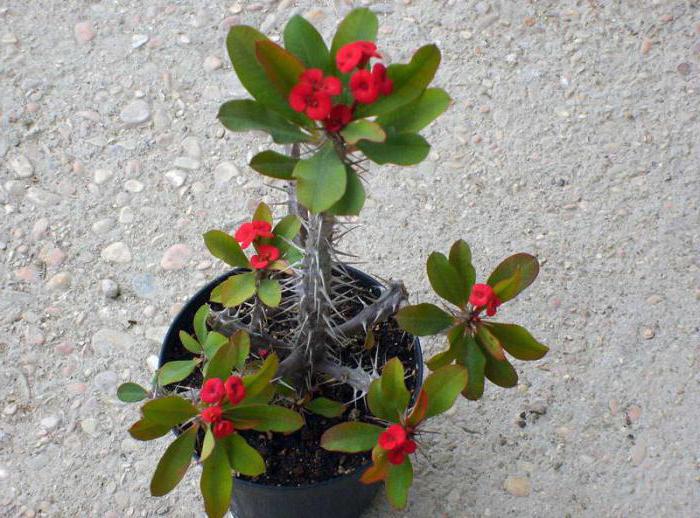

Euphorbia Mila, how to care at home
Vulcanos can be grown separately or with other succulents.
For healthy growth and abundant flowering, you need to adhere to some care rules.
- Watering. This type of milkweed is drought tolerant. This crop does not need to be watered abundantly. In summer, it is irrigated no more than twice a week. In winter, water is even rarer: when the ground is completely dry. Frequent and heavy watering will harm the plant and may kill the milkweed.
- Temperature conditions. Euphorbia Mila is considered a thermophilic species. In the summer, the thermometer in the room should be within 25 degrees. In winter, the temperature cannot be lower than 15 degrees. Cold has a detrimental effect on the plant, very low thermometer readings can destroy it.
- Priming. The flower has no soil requirements; it takes root in almost any land. You can use store-bought soil for succulent crops.
- Fertilizer. Top dressing should be added during vegetative growth, it should be done once a month. For this, it is recommended to use store-bought fertilizers that are intended for succulents.
- Shine. The lighting should be bright. It is recommended to place the milkweed pot on the south window.
- Pruning. Mature plants lose their foliage, stretch out, decay. Elongated shoots must be shortened. This stimulates the growth of new side branches. The formation of the crown of the bush should be carried out in early spring.
- Transfer. It is better not to replant a young plant. For adult bushes, it is recommended to change the soil and flowerpot if necessary, when the roots no longer fit in the pot. Before transplanting, you need to remove the plant from the pot, clean it, remove the damaged areas. Next, you need to pour a layer of drainage, earth, arrange the plant and sprinkle with soil mixture.


Important! If there is enough light, the plant will be lush and beautiful. In the case when the spurge does not receive the required amount of sunlight, it stretches, the stem becomes thinner and the leaves fall off.
As you can see from the above, home care for this succulent is not difficult. It doesn't require much care. Everyone can cope with the cultivation of this crop.
This video details the features of succulent care:
Many are interested in how to propagate Euphorbia. Here are some helpful tips. First of all, you need to choose the right time.
It is recommended to do this in early spring, in March-April. Mille spurge can be propagated in several ways.
Using seeds
Sow in moist soil. Cover the container with polyethylene on top. Put in a bright and warm room, the temperature in which is not less than 20 degrees.
Keep in such a greenhouse until sprouts appear. Seeds sprout quickly. You need to plant it when several leaves appear on the stalk.
Using cuttings
Propagation by cuttings is a very simple method. But before you cut the branches, you need to choose the right adult plant. That is, it must be healthy and have strong, thick stems.
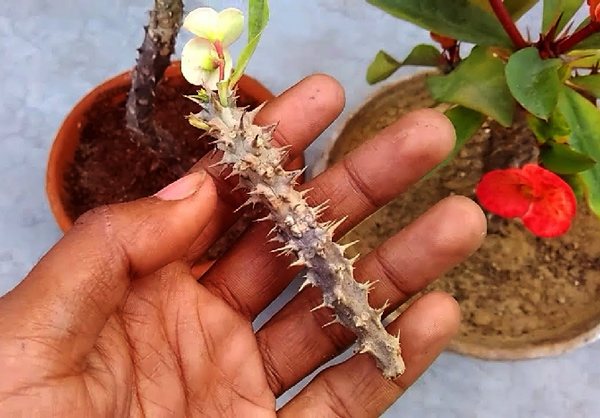

Before rooting, they must be placed in water to remove the milky juice, and then dried.You need to plant the plant in a moistened soil mixture. You need to cover it with a film.
Put the pot in the light, and keep the temperature at least 20 degrees. Water the plant after seven days.
Important! Milkweed shoots are not placed in the water for launching roots. This can lead to rotting of the cuttings.
By dividing the bush
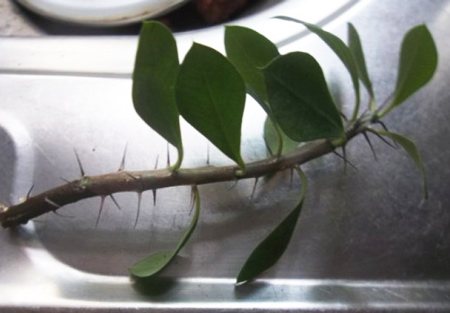

Before rooting a bush, you need to choose the right plant.
Only a specimen that has several trunks and a massive root system is suitable for division.
This will allow the split parts to take root quickly.
In order to divide the bush, you need to remove it from the pot, free the roots from the ground, carefully divide the plants into several parts. It is necessary to divide so that on each part a process is preserved. After that, each part must be planted in a separate pot with soil mixture.
How to care for a plant
Now let's tell you what kind of care this beautiful flower needs.
Watering
Often there is no need to water the plant, the earth must have time to dry out. But still make watering abundant, and use soft water.
Winter is a dormant period for milkweed, so it is better to reduce watering at this time, but not too much, especially if the flower is near the battery.
With prolonged overdrying of the earth, it sheds yellowed leaves, which significantly impairs its appearance. But if you return to his usual care, he will soon recover.
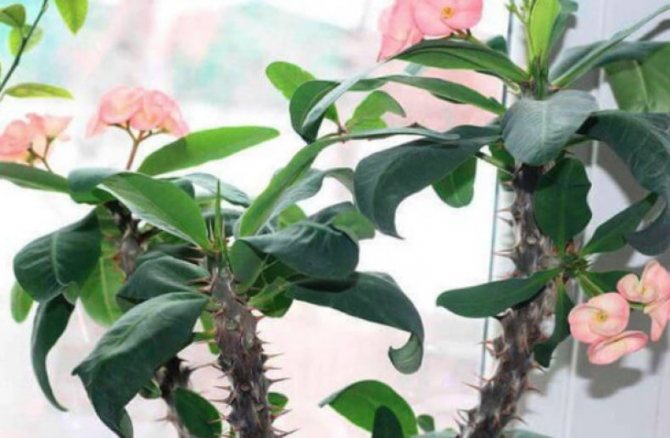

Top dressing
Euphorbia is beautifully fed from spring to early autumn, doing this once a month and preferably after watering, so that the nutrients come to the roots.
Fertilizers for cacti and succulents are perfect for him.
Pruning and shaping the crown
You can give the plant a beautiful shape whenever you want: for this, split off the tops of young shoots and remove the lateral buds, defining the horizontal direction of growth. When the flower reaches its height, cut off the top of its head.
Transfer
The transplant should be done in the spring. Young growth is transplanted annually, adult plants - as the pot is filled with roots (every 2-3 years).
Pests and diseases
Mille spurge is very resistant to disease. Basically, problems arise with improper care. Most often, the plant develops root rot. It occurs with excessive watering. This is indicated by yellowing and falling leaves. In this case, you need to immediately transplant the plants into new soil so that it does not die.
With regards to pests, the spurge in rare cases can be affected by such insects:
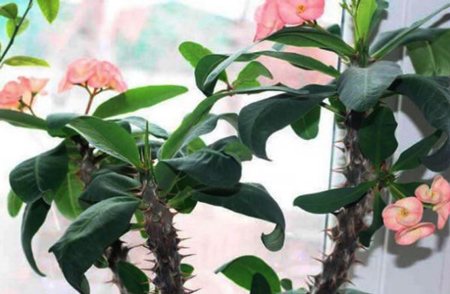

Aphids. This small insect is light green or yellow in color. Aphids live in colonies, eat plant sap. The presence of this pest is indicated by twisted leaves and the cessation of flower growth. You can get rid of insects with soapy water.- Whitefly. These are small white midges. They can be easily spotted with an unarmed eye. Their larvae are very small and green in color. They consume the sap of the plant. To get rid of them, you will need to apply insecticides.
- Root mealybug. If this pest exists, then the growth of the plant slows down, the leaves begin to crumble. When the plant is removed from the pot, whitish clusters of pests are found in the ground. If nothing is done, the plant dies quickly enough. You can try to save a flower if you remove it from the ground, clean it, treat it with insecticides and transplant it into another pot.
The large-flowered spurge is a striking and unusual plant. He is the most famous of all the Molochaev family. This flower does not need any special care. The only thing that makes it dangerous is the poisonous white juice. Therefore, you need to be very careful when caring for it.
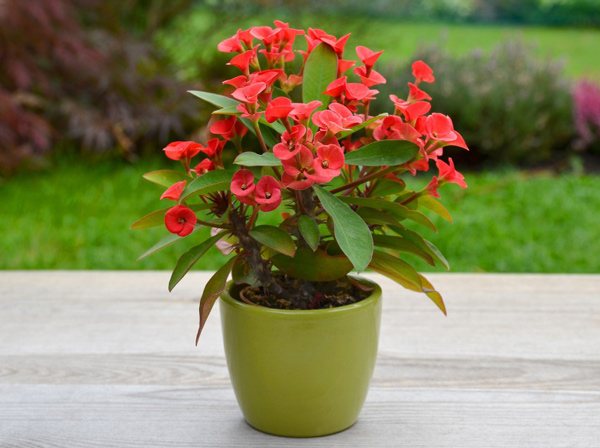

Euphorbia Mila, or Euphorbia beautiful, or Euphorbia speciosa is a succulent plant of the Euphorbiaceae family.A fairly unpretentious plant, and its appearance is able to please in any setting. Among the people, the Euphorbia Mila received the name "crown of thorns", possibly because of the abundance of thorns on its branches. In the article we will tell you how to care for this houseplant: propagate, transplant, fight pests and diseases.
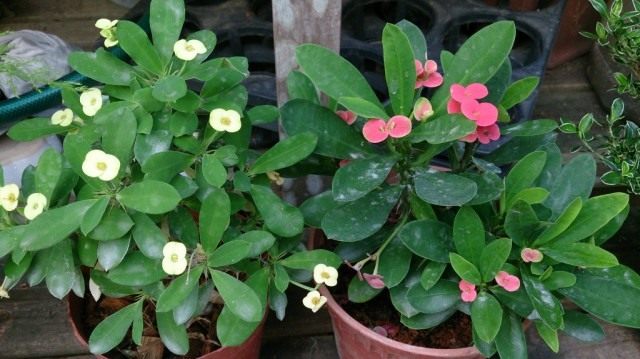

Mille spurge (Euphorbia speciosa). <>
Spurge in the office
Lovers of greenery are happy to furnish plants and their desk in the office. This can help reduce your stress levels. In this case, the spurge will be very useful, because it:
- attracts good luck;
- promotes career growth;
- attracts a positive mood for the hostess and her colleagues.
A person who grows this flower on their desktop is much more likely to quickly climb the career ladder. And here you need to be careful: if you do not give the flower proper care, then its influence can be completely opposite, which can threaten even dismissal in the near future.


Euphorbia will help in career advancement
Description Milkweed Mil
The plant got its name "Millet spurge" after the name of Baron Mil, the governor of Reunion Island, who brought this species to France in 1821. Sometimes in the literature, another name for Milkweed is used - Euphorbia splendens.
This perennial succulent shrub, reaching an impressive size in its homeland (up to two meters high), has abundant branching. The stem is grayish, slightly ribbed. At the tops of the shoots, elliptical pale green leaves are born, 3.5 cm long and 1.5 cm wide, each of them is equipped with two stipules, transformed into sharp thorns. The leaf blades of Milkweed Mille fall off with age, and strong thorns remain forever, so only the tops of the stems are covered with leaves.
The bracts of Mil's milkweed have the brightest color of all milkweed (scarlet, orange or yellow), they are round, up to 12 mm wide. Inflorescences consist of 2-4 groups of flowers, each of which is surrounded by bracts. The inflorescences are carried out from the bizarre intricacies of thorns on long green legs.
When and how to transplant a flower
When buying milkweed from a flower shop or garden center, do not rush to transplant the flower to a new location. An exotic plant is going through a hard change of permanent residence and any transplantation measures... In order for the flower to acclimatize in a new environment, they wait 10-14 days, and only then are they transplanted to a permanent place of growth.
How to transplant a plant: 1. Prepare a pot or flowerpot in advance, 3-5 cm larger in diameter than the previous one. 2. The container is scalded with boiling water, a drainage layer of small stones or crushed stone is laid on the bottom. 3. The pot is filled with fertile soil and a deep hole is made. 4. Euphorbia is carefully removed from the old container along with the soil. 5. Place the plant in a new pot with a lump of earth on the rhizome. 6. The flower is covered with soil and lightly tamped. If necessary, the plant is watered.
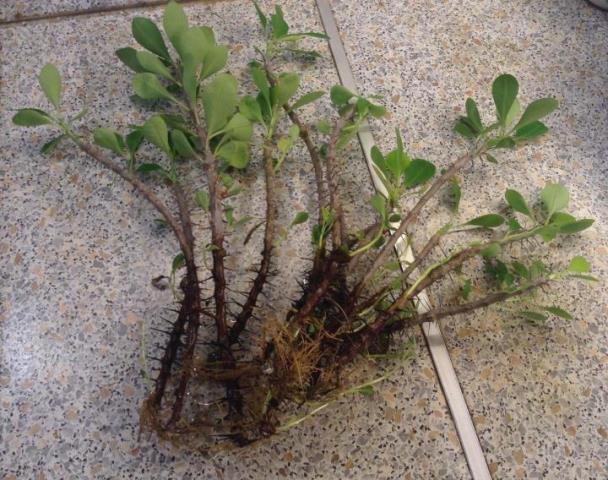

Young seedlings are actively developing the root system and transplantation is required annually. Adult flowers are transplanted no more than 1 time in 3-4 years.
Milkweed cultivation requirements
Location: bright and sunny throughout the year, outdoors in summer, sheltered, in winter at room temperature. In a cool place, Mila spurge can winter only when there is enough light and high soil temperature (near the heating device). The appearance of yellow leaves and their dropping is associated with non-observance of temperature and water conditions, as well as with a lack of light in winter. Grows well in hydroponics.
Lighting: bright light.
Watering: limited but regular. Mille spurge carries dry soil and dry air.
Air humidity: moderate, in spring and summer it is advisable to increase the air humidity.
Top dressing: they are fed only from spring to autumn, once a month, with fertilizers for cacti and succulents. The soil mixture for Mil's euphorbia should be loose and nutritious.
Transfer: Once every two to three years in the spring. The soil is clay-soddy with the addition of leaf sand and humus.
Euphorbia milii Euphorbia milii Euphorbia milii
Plant soil
If you planted this plant at home, then in the next few years you can wait for a beautiful flowering. You can take a photo with pride. Home care Milkweed Milk needs very simple, sometimes watering is enough. The plant is undemanding to soil and will grow well even in garden soil. But it is advisable to purchase a special one from flower shops. Usually this is the soil for cactus succulents.
To prepare a similar composition, you will need leafy earth (conventionally two cups), as well as a cup of turf and sand. In summer, during active growth, fertilization is required. Top dressing is required once a month. Be careful with nitrogen fertilizers! It is better not to experiment here, but to buy a special composition for cacti.
Planting and breeding Milkweed Mil
Milkweed is planted in a container with the obligatory presence of a drainage hole, laying a layer of expanded clay on the bottom. Planting in pots without a drainage hole is unacceptable: due to one improper watering, the plant can die from root and stem rot. The pot should be shallow and wide, because the root system of the milkweed is weak.
After reaching an impressive size, it is advisable to transplant Mil spurge into a heavy container or put a couple of heavy stones on the bottom of the pot to give stability. Young plants need an annual transplant into fresh soil, adults are transplanted less often - after 2-3 years in the spring.
Mille spurge reproduces by seeds, lateral processes that appear on the main stem and cuttings. Ripe seeds can be harvested and used for propagation by sowing into damp ground with light pressure. Before emergence, crops can be covered with glass or plastic wrap.
Cuttings are harvested in the summer in June-July. After cutting off the stalk, you need to let the milky juice drain off by immersing the cut for a short time in warm water. Then the wound is sprinkled with crushed coal and the cutting is left to dry for 2-3 days. Then they are planted in a sand-peat mixture and placed in a warm (not lower than 20 ° C) place for rooting.
Breeding features and planting of euphorbia
Propagated by spurge brilliant by seeds and cuttings.
Growing from seeds
This method is used less often, since plants grown in this way do not preserve their varietal characteristics.
- Collect or purchase ripe seeds from an adult plant.
- Plant them in well-moistened soil (a mixture of leaf and garden soil, turf and sand in equal parts), pressing them a little there.
- Cover crops with foil or glass, another option is cut plastic bottles.
- Place in a bright and warm room with a temperature of at least + 20 ° С.
- When the first leaves are formed on the seedlings, you need to remove the cover.
- Water in moderation.
- As the seedlings grow, plant them in separate pots.
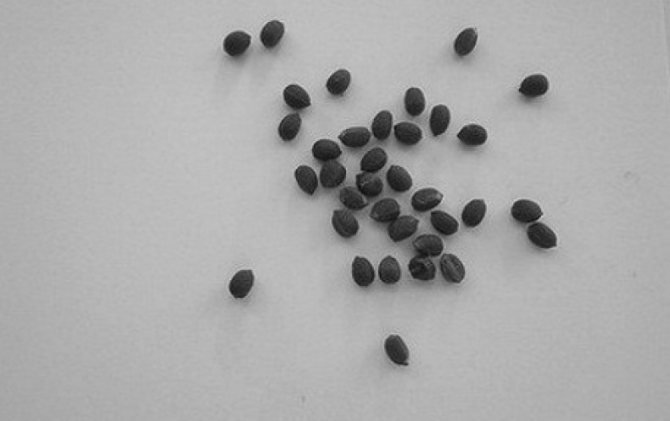

Milkweed seeds
Propagation by cuttings
This method is considered more preferable for the plant. Cuttings are recommended to be harvested from spring to mid-summer.
- Cut a stalk from an adult bush and lower it into warm water (the milky juice should drain).
- Sprinkle the wound with crushed coal or ground pepper.
- Leave to dry for 2-3 days (a protective film should form on the cut).
- Treat the stalk with a root root.
- Plant the plant in a small pot with a moist mixture of leafy soil, garden soil, turf, and sand in equal parts.
- Cover with foil.
- Install in a bright place where the temperature is not lower than + 20 ° С.
- Water after a week.
- When the stalk grows, transplant it into a large container.
- Remember to trim off any excess shoots to create a neat and healthy bush.
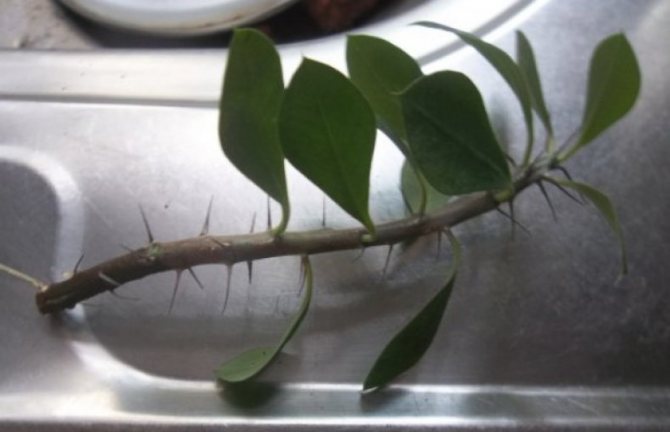

Milkweed stalk
Diseases and pests Milkweed Mil
Among the pests of euphorbia, Mil is affected by spider mites, aphids, thrips, and scabbard. With excessive humidity and low temperatures, fungal diseases develop. But if you follow the basic rules of care, then the spurge will not give you much trouble.
Aphids
Light green, yellow or pink insects. The damaged parts are discolored, the leaves turn yellow and fall off. The plant is severely depressed and stops normal development.
Control measures. Pests must be mechanically removed from the affected parts, severely affected leaves or shoots are also removed. Spraying with insecticides is then applied. If the lesion is severe, the treatment is repeated.
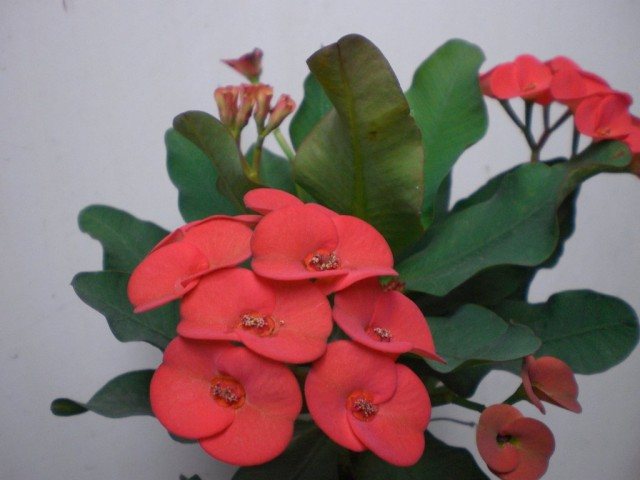

Euphorbia Mila, or Crown of Thorns.
Whitefly
Small white midge, clearly visible to the naked eye. Greenish larvae settle on the underside of leaves, suck out cell sap and leave sugary secretions. Faintly noticeable whitish or yellowish spots appear on the leaves.
Control measures. Spraying with insecticides (fufan, actellik, intavir) is required every three days. Pick up affected leaves.
Root mealybug
Affected plants slow down and stop growth, the leaves turn yellow, dry and die off. The plant will die if you do not take action. If you get the plant out of the pot, you can see in them at the initial stage, small, and then more and more spreading areas of mealy accumulations of pests and their products.
Control measures. As a pest prevention - when transplanting a plant, you need to carefully examine the roots. If pests are found, disinfect the pot, clean the roots of old soil, rinse the roots of the plant in an insecticide solution and plant in fresh soil.
Euphorbia mile (M. Milius, M. brilliant, M. mile, M. mile) is a highly branched succulent, a perennial shrub from the Euphorbia family. Under natural conditions, it grows in the arid regions of Madagascar and Mexico. In Europe, it is grown indoors. The plant is named after the governor Fr. Reunion of Baron Pierre Bernard Milius, who brought him to France.
Euphorbia mile in nature grows up to 2 m, at home its height rarely exceeds 1.5 m. The shrub grows slowly. On the tops of the thorny shoots, oval leaves are formed, which fall off in autumn. Small flowers on long green peduncles are located outside the thorns. Small bright bracts attract attention. Domestic euphorbia mile blooms almost all year round and always looks elegant.
| The shrub grows slowly. |
| Domestic euphorbia mile blooms almost all year round and always looks elegant. |
| The plant is easy to grow. |
| Perennial. |
Botanical description of the plant
Perennial shrub euphorbia or euphorbia Mila grows naturally in the mountainous regions of Madagascar. In the wild, Mil spurge grows up to 2 m.
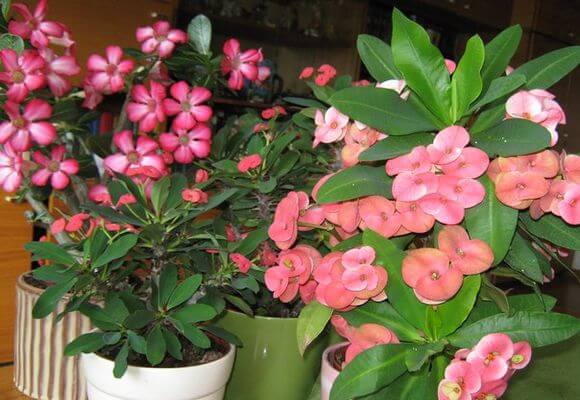

Branched stems of grayish shades with numerous oval leaves, bright green. A feature of Milkweed Mil is large thorns that grow on the tips of the twigs. The leaves gradually die off and are replaced by new ones, but the thorns remain forever.
During the growing season, a long stem grows from the top of the shoot, on which the inflorescences are located. Red, orange, white and pink bracts with dense rosettes, in the middle with small, nondescript yellow flowers. With proper care and lighting, euphorbia Mili volcanos blooms all year round.
Important! The leaves, shoots, flowers and rhizomes of Milkweed varieties contain white juice with toxic substances.
It is especially dangerous if liquid gets into the eyes, and temporary blindness occurs.The juice can cause burns on contact with the skin. Is it possible to keep an exotic flower at home, we'll figure it out.
Milkweed care for miles at home. In detail
Even a novice florist who is familiar with the preferences and characteristics of the development of the plant can grow a flower of euphorbia at home.
Milkweed bloom mi
Milkweed bloom is an attractive phenomenon, sometimes lasting for several months. The plant can bloom all year round, but in winter you need to send it to rest in a cool place.
Euphorbia mile is a dioecious plant. It has small unisexual flowers, collected in cyatia - special inflorescences, consisting of 1 female and several male flowers with stamens.
Around the flowers are small glands that secrete nectar. Flowers in citation are surrounded by a wrapper. Special rounded bracts are attached to its outer side, which can be pink, scarlet, coral, cream or purple in color. Many people mistakenly consider them to be petals.
The color saturation and the size of the bracts depend on the variety and the correct care of the plant. The flowers are not capable of self-pollination, therefore, if they want to get seeds, they place several bushes nearby.
Temperature regime
In order for the flower to develop fully, caring for milkweed mile at home recommends observing the temperature regime.
In winter, Mil's spurge is kept cool, which has a beneficial effect on its flowering and growth. The temperature can be reduced to a maximum of + 6 ° C, but + 12 ° C is considered optimal.
In summer, the plant is comfortable at + 23 - 29 ° C. In warm weather, it can be taken out onto the balcony.
It is important to avoid drafts and sudden cooling, so the flower is not placed next to the vents and air conditioner.
Spraying
Euphorbia mile, like all succulents, normally tolerates dry air even during the heating season. Air humidity in the room of about 40% is considered normal for them. Spraying of the plant is carried out rarely, and only in dry warm weather, so as not to cause rotting of the stem.
Spray a mile of milkweed with lukewarm water. They do this away from the draft and the bright sun, trying not to hurt the flowers. After spraying, the plant should dry well in the shade.
Lighting
Domestic euphorbia mile is an unpretentious plant. But the right lighting for its development is important.
As befits succulents, the plant prefers bright sunlight. He likes to be on the south window. But in summer, especially on hot days, the euphorbia must be rearranged to the eastern window or shaded to avoid burning the leaves (this is especially true for variegated species).
In autumn and winter, when the duration of daylight hours is reduced, additional illumination is installed.
Milkweed loves light from above. In low light, the millet spurge will develop slowly.
So that diseases do not arise and that euphorbia feels comfortable at home, you need to responsibly approach its watering. Watering is carried out only when the soil on top dries well. Usually in summer this happens once every 7 days, in winter - once a month, and the rest of the time - once every 2 weeks.
It is important, when reducing the number of irrigations, not to reduce the amount of water poured into the soil. Waterlogging of the soil is much more dangerous for milkweed than overdrying. Its roots are able to retain moisture for a long time. To keep the soil moist, mulching is carried out.
Milkweed pot mile
The root of the bush is superficial. Therefore, a milkweed mile pot is needed not high, but roomy, so that the root system is evenly distributed at the bottom. When picking up a pot, make sure that there is enough space in the container for the drainage layer, as well as a drainage hole. Mile Euphorbia needs a heavy, stable pot.
Soil for milkweed mile
It is believed that the mile is not picky about the soil, it can develop in ordinary land taken in the garden. But at the same time, a substrate for succulents or soil for milkweed mile, prepared at home from peat, humus, sand and sod land, taken in equal proportions, is preferable. The soil mixture should be moisture and air permeable, have medium acidity.
It is important to create reinforced drainage from ceramic fragments, broken brick or expanded clay. Brick chips are added to the substrate.
Top dressing and fertilization
Top dressing and fertilization are important for improving the appearance of the plant and increasing its resistance to adverse factors.
From mid-spring to autumn, once every 30 days, a mile spurge is watered with liquid mineral fertilizer for cacti, diluted several times.
Top dressing is carried out after watering, in cloudy weather or in the evening.
Milkweed mile transplant
A milkweed mile transplant is necessary for its full development. Young bushes need to be replanted every year, in the spring; mature - in 2, 5 years. The damaged fragments of the roots are trimmed.
A pot is selected, the diameter of which is 2 cm larger than the previous one. Drainage and part of the soil are poured at the bottom. Place the euphorbia a mile and cover it with the rest of the soil so that 2 cm remains to the upper edge of the pot (the growth point cannot be buried).
The plant is watered and left for several days in a shaded place to take root. After 2, 5 weeks, the flower can be fed for the first time.
Pruning milkweed
Mille spurge should be cut in time to heal, rejuvenate the bush and improve its illumination. At the beginning of spring, the elongated, weak and dried shoots are cut in half. Pruning stimulates the formation of new branches, making the bush fluffy.
Having cut off a fragment of the shoot, wipe the cut points from the juice with a damp cloth. The wound is dried a little and sprinkled with crushed coal. Work is carried out with gloves to protect hands from the toxic sap of the plant.
Dormant period
The plant can bloom almost all year round, but it must be stopped in time. Then the supply of vital resources will not be depleted, and flowering will resume with renewed vigor. The dormant period for the bush is organized in winter. Mille spurge is placed in a cool room and kept at + 12 ° C for 3 months. At this time, it is not fed and only occasionally - once a month - is watered. At the end of winter, they gradually get used to warmth and light.
Is it possible to leave euphorbia without care for the duration of the vacation?
If you go on vacation for a month, a mile euphorbia will calmly endure parting. Just before leaving, the plant must be watered abundantly, put away from drafts and too bright sun.
Secrets of good flowering
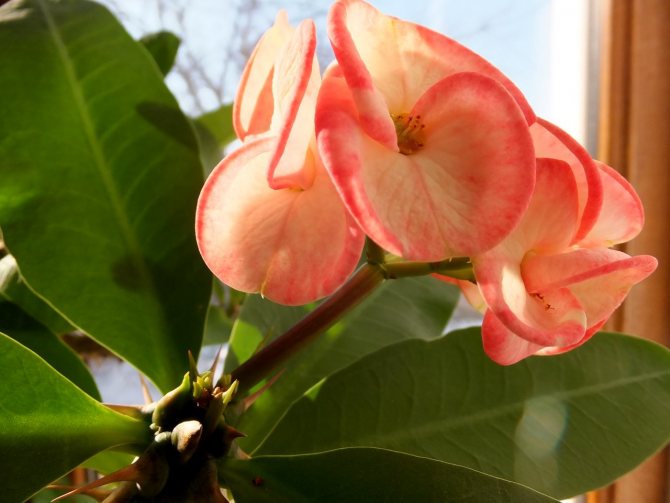

The intensity of flowering of the plant depends on the peculiarities of caring for Milkweed at home. Novice growers are often interested in why a succulent plant refuses to bloom. The main problem can be caused by lack of lighting, power supply, or too large a pot. In addition, numerous lateral shoots may be the cause, since the plant spends all its energy on their growth. Only high-quality pruning of Milkweed can help in such a situation.
Active flowering can be stimulated by moderately lowering temperatures. The temperature should not be lower than +15 ˚С. The plant is placed under fluorescent lamps. Only after 14 days, the flower can be returned to its previous growing conditions.
In order for the plant to please with an unusual appearance, you need to give it the correct shape. To do this, follow these steps:
- Gently pinch off the tops of young shoots, remove lateral buds. Thanks to this, you can set the horizontal direction for the growth of branches. This procedure can be carried out at any time of the year.
- Trim the crown off the succulent as soon as it reaches the desired height.
- Regulate the growth rate of the flower and the splendor of the crown.
New buds and shoots appear when the light intensity is reduced.If the grower increases the amount of light, new buds will begin to develop at a temperature of + 17 ° C.
Milkweed propagation by cuttings
Milkweed propagation by cuttings is carried out in the spring, but if the flower begins to rot, then the cuttings are cut at any time. In this case, propagation by cuttings becomes the only possible option for preserving the plant.
Cuttings are cut from Milkweed, the length of which is 15 cm. They must have at least 3 leaves. The cut site is washed and rubbed, otherwise the viscous juice will flood the wound, and rooting will be difficult. The planting material is placed in a dark, dry place for several days so that a film appears on the cut.
After that, the cutting is left to root in a peat-sand mixture at + 20 ° C. After the appearance of small roots and 2 - 3 new leaves, euphorbia is planted a mile in a pot.
Diseases and pests rarely affect euphorbia, but sometimes unpleasant symptoms appear that worsen the appearance of the plant:
- the lower leaves of the milkweed fall off - if the plant is mature, it is a natural physiological process; in young people - lack or excess of moisture in the soil; low temperature (adjust watering; rearrange to a warm place);
- the stalk of the milkweed rots - a fungal disease due to excess moisture; overfeeding with nitrogen; lack of light and heat; poor drainage (stop watering; treat with a fungicide; transplant into new soil with enhanced drainage; rearrange to a warm, lighted place);
- spurge does not bloom - insufficient lighting; too large a pot; lack of nutrition due to increased growth of side shoots (rearrange in a bright place; transplant into a smaller pot; cut off side shoots);
- milkweed leaves wither - insufficient watering (water abundantly);
- brown or black spots on the leaves - fungal infection (treat with a fungicide);
- yellowing of the ends of milkweed leaves - lack of moisture in the soil or calcium deficiency (water, feed);
- the appearance of a cobweb - an attack of a spider mite with too dry indoor air (wipe the leaves with soapy water, rinse in the shower; spray regularly);
- milkweed leaves bend, dry and fall off - defeat by mealybug (wipe the flower with soapy water, rinse in the shower; in case of severe damage, use Actellic).
Spurge mile infect pests: spider mites, scale insects, aphids, root worm, thrips, whitefly.
Common problems
| Leaves turn yellow and crumble. | Autumn is a natural phenomenon. The rest of the time, lack of moisture and cold leads to leaf fall. | The conditions of detention are being adjusted. |
| Softening the stem, curling the leaves. | Waterlogging of the soil. Root decay is possible. | The plant is transplanted into fresh soil, removing damaged roots. Repeated insecticide treatments are recommended. |
| Fading of leaves, stretching of the stems. | Lack of sunlight. | Move the flower to a more illuminated place. |
| Yellowing of the leaves, the appearance of a small cobweb on the back. | Spider mite infection. | The plant is sprayed with Actellik three times at weekly intervals. |
Euphorbia Mila is one of the most beautiful and interesting representatives of Euphorbia. It has a beautiful flowering, interesting structure of the bush. By shaping, you can give milkweed any shape, use it when creating compositions from succulents.
Milkweed varieties mile home with photos and names
There are many hybrid varieties of Milkweed. Some of them are the most popular in indoor floriculture.
"Natali"
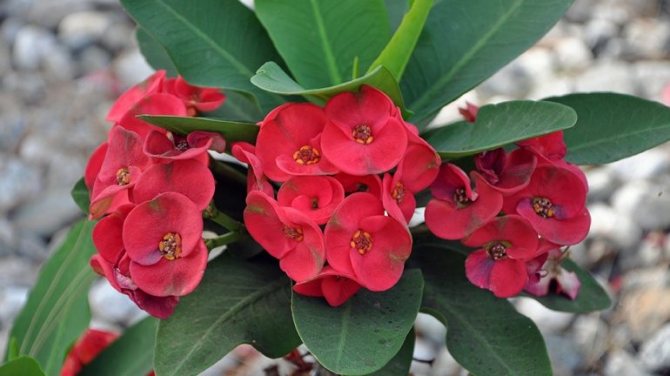

Beautiful bushes with bright green foliage. Delicate pink bracts with darker blotches or stripes.
"Sonora"
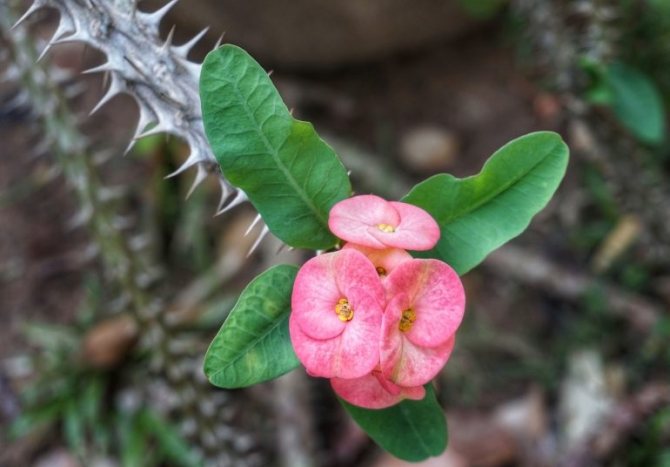

Delicate, slightly velvety bracts are bright pink in color.
"Moonlight"
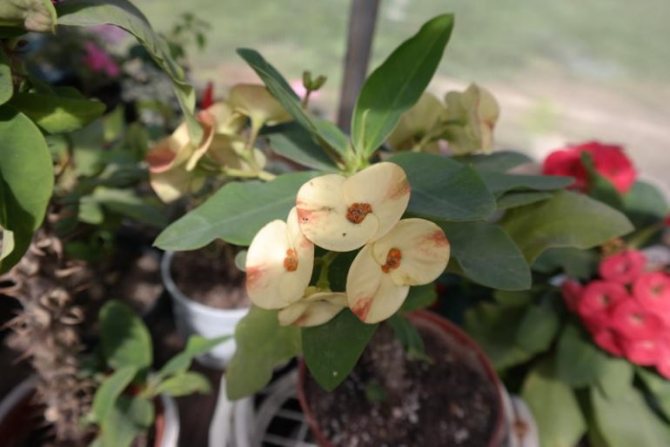

Against the background of green leaves, yellow bracts with an orange center look fresh.
"King Yellow"
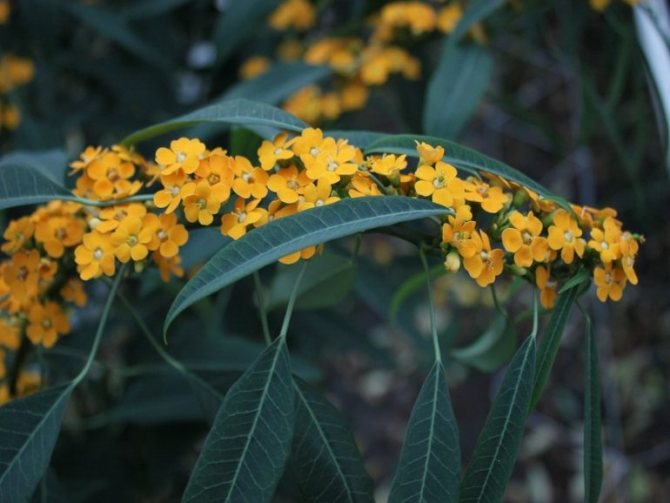

The dark green leaves are elongated. Bracts are bright yellow.
"Sakura kiss"
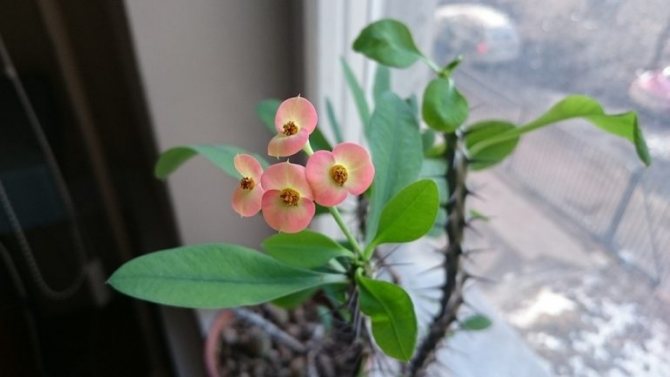

Bracts are snow-white with frequent blotches of pink.
"Bojeri"
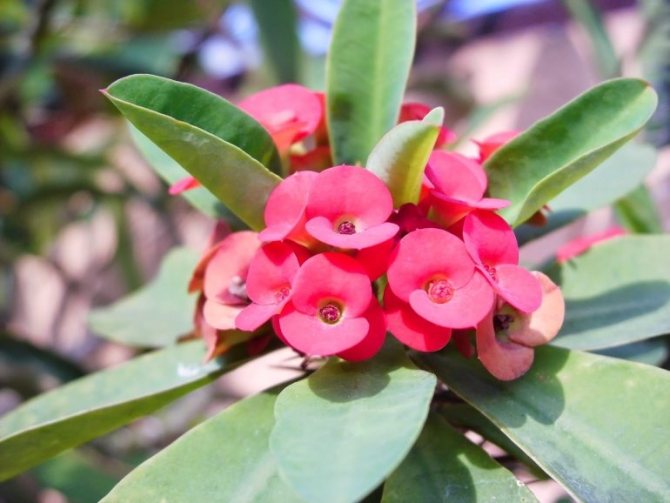

Shoots are thin, elongated. Bracts are deep red. Blooms profusely in the warm season, in autumn - in moderation.
"Lutea"
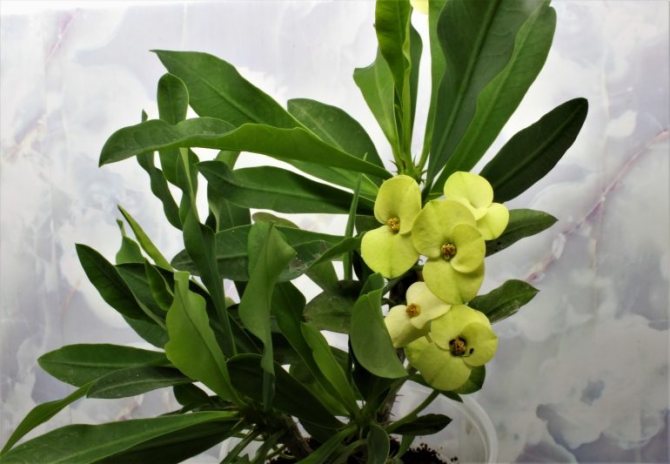

Delicate golden bracts stand out against the background of bright green foliage. The bush blooms profusely.
"Nam Choke"
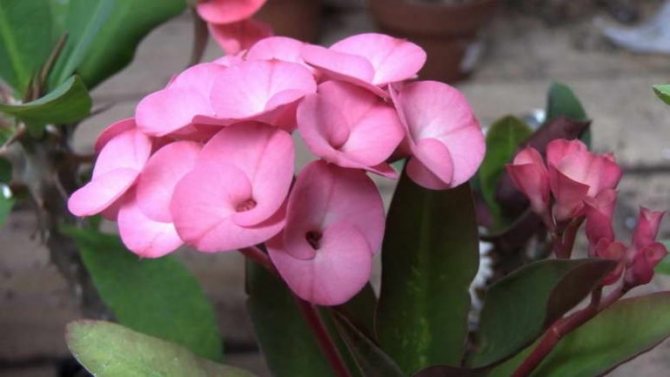

Carmine bracts. It blooms profusely and for a long time. The bush is compact. Shoots with sharp thorns. It grows slowly, does not need frequent pruning.
Euphorbia Mila is a bush covered with thorns. Despite the outward inaccessibility of the plant and the poisonous juice contained in it, it is always popular with flower growers. The secret is simple: the bush is decorated with bright flowers almost all year round, bringing joy to the house.
The history of breeding varieties
The birthplace of this culture is the mountainous regions of Madagascar and the adjacent islands. This Madagascar species of milkweed is also widespread in South Africa and Mexico. For the first time in Europe, this plant was brought by the governor of the French island of Reunion - Baron Milus, in 1821. Originally, this type of milkweed, due to its tallness and sharp thorns, was used for dense hedges. But over time, due to the long and beautiful flowering, they began to cultivate it as an ornamental plant, to decorate winter gardens, greenhouses.
On a note. Due to the characteristic shine of the leaves, as well as the large number of thorns, this plant also received such characteristic names as euphorbia and Crown of Thorns.
Conditions for growing at home
The indoor form of the plant does not impose special requirements on the conditions of detention. Considering that it is a thermophilic succulent, it is able to “contain” itself for a long time at the expense of its own reserves.
Lighting and ventilation
Euphorbia loves diffused sunlight, so it can be placed on southern windowsills, slightly shading with a transparent curtain. In this case, the plant will receive enough heat, and its leaves will not be affected by the sun's rays. In summer, it is recommended to take the pot out to the loggia, balcony or into the courtyard of a private house.
Did you know? According to folklore, both wild and domesticated euphorbia are able to help people who suffer from chronic diseases of the gastrointestinal tract, heart and psyche.
In winter, daylight hours must be extended through the use of artificial lighting. This species is not afraid of small gusts of wind, so do not restrict their access. It is not necessary to put a flower in a draft, and in the fresh air a sudden wind will not harm the plant.
Temperature and humidity
Spring and summer temperatures for optimal well-being of the bush - up to +26 ° С. In the autumn-winter period, when the spurge is at rest, the permissible degrees for keeping are + 15 ... + 18 ° С. A decrease in temperature to + 12 ° C will lead to the death of the plant from freezing of the roots. Air humidity is not the most important factor for this species, as its fleshy stems and leaves are high in liquid and nutrients. Leaves should be periodically wiped with a damp natural cloth from dust.
Output
According to signs and superstitions, euphorbia has many positive properties. One of the most beneficially influencing its varieties is the white-spiked euphorbia, but you should keep it in your home or office only when you are ready to constantly take good care of it, otherwise the flower can lead to failures, quarrels and chronic ailments.
The manifestations of the negative energy of a flower can be facilitated by its incorrect location.
All these factors are really important to take into account if the hostess decided to start a plant of this species. Then it will not only delight with its appearance, but also bring happiness, joy and wealth to the house, and improve health.
Home care
Caring for a Milkweed indoor bush is not very difficult.It is enough to water it on time, feed it, replant it as needed.
When the top layer of the soil dries up, the plant is watered. The bush should not be flooded too much, but the moisture should be of high quality - under the main stem of the plant. The water temperature for irrigation is selected at room level (or slightly cooler). The plant does not tolerate dry soil and air - under such conditions, it must receive a sufficient amount of moisture. In summer, Mila spurge is watered 2-3 times a week, and in winter - as needed, when the topsoil dries out.
Important! When watering some plants, do not allow water to enter the leaves and base of the stem. In this way, the formation of fungi can be avoided.
Top dressing
You need to feed the bush every month during the period of active growth - in spring and summer. Any feeding for cactus and succulent plants is used, which includes nitrogen, phosphorus, potassium, calcium. Fertilizers are applied in a small amount under the base of the stem, and after 1-2 hours the plant is watered.
The formation of a milkweed bush is carried out at the request of the owner. You can let everything go by itself and let the plant lose its shape, or you can form a beautiful crown for this succulent. How to cut the shoots, each grower decides for himself. Usually, the branches are shortened by a third, and the withering, drying, old shoots are completely removed. The crown after trimming should have a semblance of spherical and look fresh and well-groomed.
Due to the weakness of the root system, a planned plant transplant is performed with extreme caution. Given the low growth rates of this species, it is worth replanting once every 2-3 years. The new pot is only taken one "size" larger. It is also worth planning in advance how and with what to root Mil's euphorbia in a new container.
Varieties
Today, many varieties of milkweed are known, each of which has certain characteristics.
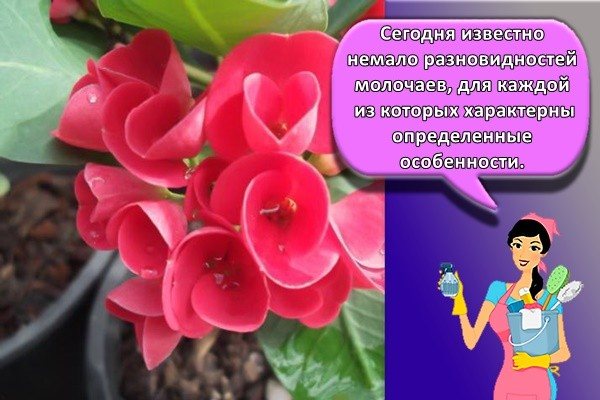

White-veined or white-veined
This plant has dark green foliage. Young bushes have white veins, but after a while they lose this shade. Over time, leaves appear only at the top.
Mile
It is a large bush with thorns. The ends of the shoots are decorated with small leaves, and the small flowers form red or yellow inflorescences.
Triangular or triangular
It is a stem succulent that has triangular stems. The plant is characterized by red-brown thorns. The culture is capable of reaching 2 meters.
Bordered
This plant is characterized by straight stems measuring 80 centimeters. They are covered with oval leaves of a light shade.
Tirucalli
This is an unusual plant that has many leafless shoots. The leaves of the culture fall off, not having time to grow. Flowering is very rare.
Comb
It is an evergreen shrub that has a thick stem. It is decorated with oval leaves measuring 20 centimeters. The flowers are white or pink in color.
Brilliant
This plant is characterized by the presence of thorns and small leaves. The flowers are small in size and have rich flowers.


The most beautiful
Poinsettia is considered a spectacular type of milkweed. The bush reaches 40-50 centimeters and has straight stems and large leaves. Bracts are large in size and can have a white, red or pink tint.
Medusa's head
The plant is characterized by a thickening in the upper part of the stem and branches, which diverge in different directions. The culture looks very unusual.
Fat
It is a small cylindrical plant that has tubercles. The green trunk is striped and has no thorns.
Enopla
In appearance, the culture resembles a cactus and is 30-100 centimeters in height. Shoots are distinguished by their cylindrical shape and rich green color.
Possible growing difficulties
Growing a plant indoors, there are no particular difficulties.Given that it is a succulent, watering can be limited - the bush will feed on its own reserves.
Why does not it bloom
Lack of flowering signals problems. In the case of succulents, the cause of the disturbance in the flowering phase is excessive watering or insufficient lighting of the bush. It is necessary to rearrange the pot to a warmer windowsill and adhere to the watering rules.
You will also be interested to find out why the Decembrist does not bloom.
Diseases
Milkweeds are not too susceptible to diseases, but some ailments do not bypass them. Most often, the plant is attacked by fungi. Among them:
- Alternaria. Causes concentric spots on foliage, which are treated with fungicides such as "Ridamil Gold" or "Skor".
- Gray rot. Brown and gray putrefactive spots spread on the stems and leaves, which need to be treated with the fungicides Vitaros, Fundazol, Rovral.
- Stem rot. It can develop all over the stem and down to the roots. It is treated with systemic drugs "Previkur" or "Ridomil".
- Bacteriosis Occurs with mechanical damage to the bush. Good care will be needed, including removing damaged parts.
- Euphorbia mosaic. The color of the mosaic type appears on the leaves, the leaf blades can grow unevenly. You can avoid the disease by using carefully examined cuttings for reproduction (only healthy ones are suitable).
Important! If it is not possible to replace the soil, the old soil can be calcined. Then it is fertilized and used again. This applies not only to milkweed care.
Pests
Pests do not bypass Mil's euphorbia. The main harmful insects and methods of dealing with them:
- Aphid. Red, pink and lemon-colored insects are able to eat juicy leaves, which lose their color and crumble. The bush is carefully examined, the parasites are washed off with water or removed by hand, and the most affected leaves or plant parts are completely removed.
- Whitefly. This small midge can cause serious damage. Its green larvae are located on the lower part of the foliage, sucking the juice out of it. To combat these pests, you need to treat the bush with insecticides "Aktellik", "Fufanon", "Intavir" twice a week. Affected leaves are removed.
- Spider mite. This insect is clearly visible when inspecting the plant. You need to remove it from the foliage with a stream of warm water, having previously protected the soil from waterlogging. If the mite colony has become massive, then the pot is treated with insecticides for succulents.
- Mealybug. Shoots, leaves, and roots look like they've been sprinkled with flour. If symptoms appear, it is necessary to take the following measures: treat the roots with a solution of an insecticide for cacti, transplant the bush into a new substrate and a new pot. Fertilize the soil and water abundantly.
Landing
Every plant needs soil, but the first thing to do is find the right pot. Today this can be done in online stores, guided by the photo. Euphorbia Mile home care requires minimal, but we will return to this a little later. So, the root system of a desert plant is pivotal and very well developed. Therefore, the pot should be high, slightly narrowed.
Two-thirds of it should be filled with expanded clay to ensure good drainage. It can be wet pebbles or broken brick. If your plant has grown from an old pot, then each new one needs to be taken a few centimeters more. If you take a large one at once, then the plant will most likely stop blooming.
In order to ensure normal growth and development, it is necessary to think in advance about the presence of drainage holes. This is especially important if the soil is selected incorrectly.
Beneficial features
Phytoncidoactive plant. Biologically active substances secreted by its cells reduce the concentration of pathogenic microorganisms in the air by almost 65%; have a detrimental effect on Escherichia coli, Staphylococcus aureus.
In the room where the mile euphorbia grows, people calm down, feel a surge of strength. The attractive appearance of the flower evokes pleasant emotions. Milky juice of milkweed is toxic, but in small doses it is used for medicinal purposes. Since ancient times, they used to bleach their skin, remove corns and warts.
Signs and superstitions
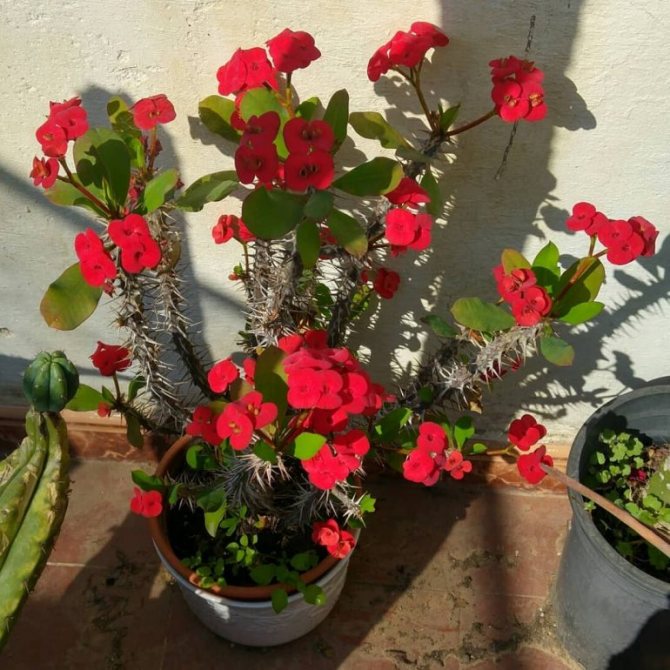

It is believed that the spurge plant brings happiness to the home. Spreading powerful positive energy around itself, euphorbia creates a favorable atmosphere and good relationships around itself. The energy of the flower improves immunity and improves mood.
Signs associated with the color of flowers
As a rule, omens associated with flowers do not bode well. Often, flowers that bring misfortune to the house are also divided according to their color. For example:
- White flowers symbolize purity and innocence. That is why there is a belief that it is better for newlyweds to give flowers of this color to a wedding.
- Red flowers symbolize passion and love.
- Yellow flowers foreshadow an imminent separation.
- It is customary to give blue flowers to close people, as they symbolize sincerity and kindness.
Seat selection
For milkweed, not only care is important, but also a place in the house that is fertile for its growth and development. Below are some tips for proper placement.
- The best place for him is in the corridor, but at a distance from the doors.
- If you keep a plant near the entrance, it becomes a kind of shield and amulet against negative influences, energies, and dangers.
- You cannot put it in a toilet or bathroom, because in this case all its positive energy will flow away with water, the negative impact will remain.
- Keeping it close to water all the time can bring chronic diseases into the house.
- You cannot put euphorbia in the bedroom if the sleeping couple is planning to add to the family, since it will interfere with conception.
- You can not put it in a room where children sleep or constantly play, since its energy can have a negative effect on them. There is also a scientific explanation for this prohibition: milkweed juice is poisonous and can cause poisoning and burns, and pricks of thorns can also have negative consequences for the health of even an adult body.
- It is advised to put it in the living room only during flowering, because then its magical power is at its peak. Later, the flower will need to be removed to another place.
Poisoning with milkweed juice
If the plant sap has nevertheless entered the human body, then it is necessary to act according to the following algorithm:
- take care of providing the patient with peace - physical and emotional;
- the patient is given an enterosorbent - activated or white coal, Enterosgel, Polysorb, etc.
- you can quickly remove toxins from the body with the help of saline laxative solutions, for example, Magnesium sulfate;
- a poisoned person should drink a lot - water, mineral water, jelly, non-acidic compotes.
Monstera
Monstera is a fast-growing vine with carved leaves. In China, it is customary to give it to respected elderly people, as it is believed that it can influence the increase in the number of days a person has to live. Because of this sign, there it is considered a wonderful gift for almost any occasion. However, in our country, people's superstitions about keeping a monstera in a house are radically different from Chinese ones. It is believed that this is one of the most dangerous vampire plants that absorb human energy, which makes people lethargic and apathetic. In addition, it is not recommended to start it in families where there are people with heart disease or lung problems, as at night it can "strangle" a person.
But the monster can be placed in a public place where a lot of negative energy accumulates, for example, in a court. There she will not only delight you with her appearance, but will also consume excess negative energy.
Signs and superstitions
In places where milkweed grows naturally, local residents try to avoid contact with the milky juice that is released when the plant is cut. Caring for indoor species must be carried out with gloves. It has long been popularly believed that euphorbia brings peace to the house. They say that during flowering, the owners of the plant must be helped by luck.
Did you know? Some plants are kept at some distance from the entrance to the house (not in the house!). So they protect the home from external negative energy, bad thoughts and protect from bad people (for example, pandanus is a kind of palm tree).
Euphorbia Mila is an unusual and very beautiful houseplant, and its care is simple.
About the benefits and dangers of the plant
According to the signs, the flower contains life-giving power, which it transfers to people. Therefore, despite the unpleasant properties, spurge at home can bring many benefits.
Thanks to the energy of the plant, family members are always in a good mood, the number of quarrels decreases, peace and tranquility come. Many people get rid of constant fatigue under its influence.
Signs say that the indoor euphorbia flower brings the following positive changes to the house:
- helps to relax, release all stress, both physical and psychological;
- has a beneficial effect on bone tissue;
- prevents the occurrence of various pains;
- attracts good luck during the flowering period.
The time when the buds bloom on the plant is generally considered the most favorable in omens. Then it is recommended to put it in the living room to decorate and attract happiness. But, after the inflorescences fall off, it is better to return it to its previous place.
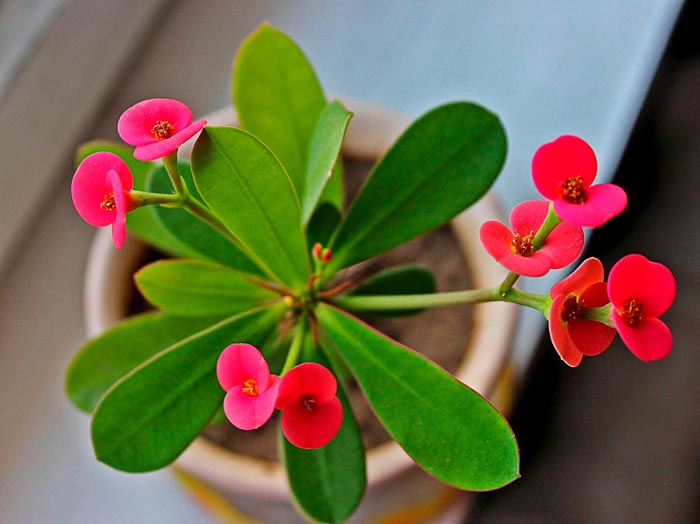

Popular varieties
Indoor euphorbia Mil has several types that differ in color:
- Sakura kiss. The flowers consist of white petals with pink dots.
- King yellow. It differs from other varieties in bright yellow monochromatic inflorescences.
- Moonlight. The flowers are yellow, closer to the base of the orange tone.
- Natali. This hybrid forms pale pink inflorescences with stripes a couple of shades darker.
- Sonora. The flowers are light pink with brighter bracts.
Large-flowered. A variety with beautiful bright red inflorescences of large size, 3-4 cm in diameter. Flowering lasts throughout the year.
Basic data
The main superstitions associated with indoor plants are based on their death. So, for example, if a plant dies, it is believed that it took the misfortune away from the owner, and the opinion that stolen flowers take root better destroyed many beautiful plants, from which cuttings were separated without the consent of the owners.
Signs that there are indoor plants that bring misfortune to the house were formed only in relation to the most popular house plants. As for the species that have recently appeared in flower shops, such as orchids, they simply have not yet had time to earn a negative attitude towards themselves. At the same time, it is likely that in a few decades they will "grow" with their own signs.
Below are the most famous houseplants that bring unhappiness, signs about which are often extremely contradictory.
Pruning
It is recommended to perform this procedure after the end of the flowering period. In a greenhouse, the timing may get lost, but usually this period falls in the fall. The tops of strongly elongated shoots must be cut off. In addition, dry leaves and shoots are cut. As a result, a beautiful and compact bush is formed.
In the spring, you can repeat the procedure. In this case, you need to remove the renewed shoots. This way you can achieve abundant flowering. Of course, some growers ignore this rule, but as a result, the bush is not the most accurate. Large-flowered spurge Mila is a real decoration of your windowsill.
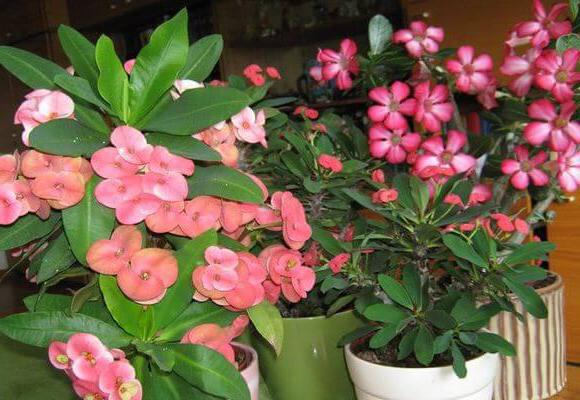

The benefits of indoor flower
Euphorbia is the most beautiful or Christmas star, blooming in the house in winter, will bring good luck and prosperity to its owners in the new year. If you arrange a flower in your home office, you will be able to focus on business, and the result, as well as career growth, will not be long in coming.
Moreover, spurge has healing power:
- In North Africa, the plant was used as a diaphoretic and diuretic, with its help healed wounds, relieved swelling and even paralysis, used it as a general tonic, and also prepared an antidote for rattlesnake bites.
- In ancient Russia, euphorbia was used as an emetic and diuretic; warts, calluses and moles were removed, and purulent wounds were treated.
- The inhabitants of Siberia used milkweed herb to get rid of kidney diseases, used it as an antineoplastic agent in the fight against certain types of cancer, treated impotence, and also used it to prepare a tonic drink.
Important! It is not worth using euphorbia as a medicine without appropriate knowledge, since the plant sap becomes medicinal only after special treatment. When fresh, it is poison.
Alternative ways
It often happens that a person cannot find an adult plant from his acquaintances, but he really wants to get one when he sees it in the photo. Milkweed Mile care is practically not required, which further spurs the desire to decorate your windowsill with it. What other ways are there?
- You can buy a package of seeds. But this method is used very rarely. Plants obtained in this way do not retain varietal qualities.
- Bush method. Sometimes "plots" come to shops. These are dug out bushes of mature plants, cut into several parts. They are not easy to find on sale. If you have a large bush that you want to divide into several parts, then you need to dry the soil. Then gently shake the plant out of the pot. The roots must be thoroughly cleaned and cut into pieces. Rinse off the juice and leave the roots to dry.
Cyperus
It is believed that this plant has such a powerful energy that it easily suppresses the human biofield, exerting a powerful negative effect on the health of people who are in close proximity to it every day. People who have him at home are often and seriously ill. Despite the fact that today there is no scientific evidence of this fact, if you nevertheless decide to have cyperus in the house, be sure to listen to your well-being.
Description and distribution
Euphorbia Belozhilchaty is an original decorative culture, loved by flower growers for its unpretentiousness and attractive appearance.
Where do you come from?
The homeland of this species of milkweed is the island of Madagascar. Also distributed in the subtropical regions of Africa and Central America.
What does it look like?
The base of the stem is thin and dense. Closer to the top, the stem becomes noticeably thicker. The surface is ribbed. The ribs are studded with small spines. The top of the trunk is crowned with elongated leaves. They have a rich green color. White streaks are clearly visible on them.
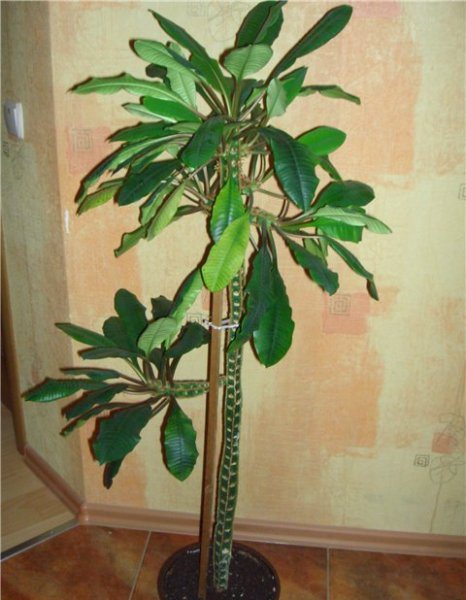

Plant height can reach one and a half meters
White-veined euphorbia can grow up to 1.5 meters.
Milkweed flowers are white. They are small in size. The flowering culture lasts throughout the spring-summer period. It usually blooms only in the second year and only with proper care.
However, flower growers do not appreciate the white-veined euphorbia for flowers. The fruit is represented by a seed capsule. Seeds often fly apart, they can get into neighboring plant pots.
Danger of the spurge plant
All types are poisonous... Their stems and leaves contain milky juice. It contains a substance called euphorbin.
Therefore, when transplanting and reproducing culture you should be extremely careful, it is recommended to wear protective gloves.
If the juice gets inside, it is required call a doctor immediately... The following symptoms are likely: dizziness, nausea, fainting, paralysis, heart failure, and so on.
In this regard, it is recommended to keep spurge as far away from children and pets as possible.
Beneficial features
Culture has long been used in folk medicine. To this day, people use all parts of the plant (leaves, stems, roots, flowers and milky sap) to treat many diseases.
Chopped milkweed root
Milky juice has a number of actions:
- Diuretic
- Diaphoretic
- Laxative
- Anti-inflammatory
With the help of milkweed diseases are treated:
- Burns and non-healing ulcers
- Diseases of the stomach
- Kidney disease
- Cystitis
- Hemorrhoids
- Other
Parts of the plant are used by pharmacists in the preparation of medicines. And people from parts make tinctures based on alcohol and broth.
Contraindications:
- Pregnancy and lactation
- Childhood
- Heart disease and hypertension
- Serious lung disease
Can I keep it at home?
Despite the danger of white-veined milkweed, it can be kept at home. However, you need to be careful with him. You can not put the plant in the nursery... If there are small children in the house, then it is better to keep it out of their reach.
The same goes for pets. Although animals do not intuitively approach plants, the trouble is better prevented.
Many lovers of indoor plants furnish all zones in their apartments with them, without even thinking about whether these plants can harm the inhabitants of the home or benefit! But in vain!
Today, many superstitious "experts" throughout the entire district only insist that most plants have an extremely negative effect on humans! It is not only about the constant setbacks and problems that haunt the owner of such "flower" apartments, but also about family problems, illness, divorce, death and terrible ailments of loved ones, money waste and elementary bad luck.
Realizing this, most of these gardeners try to decorate their homes only with "proven" plants that do not have negative effects on either the animals that live in the house or the owners themselves, and sometimes they quite succeed!
Euphorbia can be considered one of the "fashionable" plants. You can meet him in almost every organization and home. The fact is that the plant is not only flawlessly beautiful and outwardly perfect, its genus belongs to a very large family, in which there are at least 2,000 varieties of this plant, 160 of them are grown in Russia!
Therefore, many flower growers do not even know that euphorbia grows in their house. And this is not surprising, because the spurge is very diverse in its appearance. It can be small grass, or a large shrub, or a huge plant that looks more like a tree than a flower.
There are probably signs about euphorbia that will tell you more about this flower. Let's find out if this is so? If you listen to the science of Feng Shui, then we can say with confidence that no plants that have thorns should not be in the recreation and marriage zone! They supposedly negatively affect the relationship between the sexes. And euphorbia is just one of these types of indoor plants.
But in all other respects, no one says anything bad about the spurge! On the contrary, it is believed that this plant gets along quite neutrally with humans and other inhabitants of the house (animals, plants).
Euphorbia has absolutely no bad effects, which is why there is practically no acceptance with this plant, except that you do not need to keep this flower in the bedroom, that's all! Although, from the point of view of science, it is advisable to keep euphorbia away from children and animals, since the sap of the plant may be poisonous for them.
What properties does the houseplant have according to Feng Shui?
Lovers of flowers and plants do not lose the opportunity to make a new green friend in their home. However, they do not always take into account the peculiarities of Feng Shui, therefore, sometimes the plant finds itself in an unsuitable zone for it, thereby starting to negatively affect the people around it. Therefore, before you start growing milkweed in your home, you should get acquainted with its Feng Shui properties.
The presence of milkweed in the house
As you know, all plants have tremendous power, because they are alive, so they can spread their energy to people. Euphorbia is no exception, besides, it is a very beautiful plant, and few would refuse its presence in their home. After all, in addition to his life-giving power, he is able to create harmonious relationships in the family and reward the owners with positive emotions. It gives peace and relieves any stress from a person, which can be both spiritual and physical. Also, euphorbia has a beneficial effect on the human skeletal system, showing its strengthening functions, and also protects it from the occurrence of various pains. Therefore, already, based on these properties, it becomes obvious that euphorbia is a houseplant that should be kept in every home. And when the plant begins to bloom, then thereby, it attracts happiness and good luck to the house. However, if you do not provide the plant with proper care or keep it in an inappropriate place, then all its positive qualities can turn out to be negative. And then the plant can cause unhappiness in the family, quarrels and strife, and, of course, frequent illnesses of anyone of their owners.
The presence of milkweed in the office
Sometimes it is useful to keep spurge not only at home, but also at work. After all, its positive properties are capable of attracting good luck, and, consequently, career success. A person who has this flower in his office has a better chance of moving up the career ladder or just getting an unexpected bonus. Also, the attitude of colleagues and superiors will be very good, so a person's mood will always be at its best, because he will receive from work everything that many can only dream of. However, there are some nuances here, because if you do not take care of the milkweed, then all its properties will begin to manifest from the absolutely opposite side, therefore, it is possible that you will have to forget about your career at all. After all, feng shui of flowers is, although it is helping people to achieve success in certain matters, but after all, people themselves should show gratitude to plants.
Plant care
As already mentioned, in order for the spurge to have only good properties, it must be looked after, but this must be done very carefully. The plant, although it seems harmless, nevertheless, it has thorns that can not only hurt someone who touches it, but also release its acrid juice. Therefore, first of all, you should be careful. You also need to take care of the soil for milkweed, because it must be clay and always with the addition of fine gravel or sand. Lighting and temperature also play a significant role in caring for the plant, so the flower should be kept only in the place where the sun's rays will fall on it, a window sill is ideal for this. o concerns the temperature, it should be about 10 degrees, but at the same time not lower than seven, and in the summer, the plant should be given access to fresh air. Watering indoor euphorbia is not necessary as often as many plants. First, the soil should dry out between waterings, and the watering interval itself should be two weeks. But on too hot days, you need to water the flower once a week. And in winter, when the leaves completely disappear, the plant does not need to be watered at all. It is recommended to feed the spurge with potash fertilizers only 3 times per summer.Also, if the flowers have dried up, then you should get rid of them as soon as possible, because otherwise the plant can bring misfortune to the owner. If all these conditions are observed, then the euphorbia will feel that it is respected, therefore, it will thank the owners as much as possible for this, extending its wonderful properties to them. Otherwise, the situation may turn out to be the opposite, so if people do not have a desire to devote time to their plant, then there is no point in hoping that their life will be happy.
Milkweed location
The correct position of the flower in the house is also an important aspect. Indeed, sometimes, observing all the conditions for caring for the plant, people begin to wonder why the euphorbia flower does not bring any success to the family, but, on the contrary, provokes negativity. after all, the reason may be that he is simply in a bad place. It is best to keep the plant in the hallway, but not very close to the doors. Due to the presence of thorns, the spurge becomes a talisman and shield for the house, not letting in possible danger. In no case should you put the plant in the toilet or in the bathroom, because all its energy will be washed off along with the water, as a result, leaving only negative moments in the flowers. It is also possible the appearance of chronic diseases if you keep euphorbia constantly near water. It is also not recommended to keep spurge in the bedroom, especially if the couple is planning to conceive a child. After all, the flower will interfere with this in every possible way, so you can forget about having children in the near future. It is also not advisable to keep a flower in the children's room, because it does not have the energy that is suitable for children. In the living room, the spurge can be kept only if it begins to bloom, since it is at this moment that it possesses the most magical power. But it should be remembered that after the flower has faded, it must be removed to its place.
Euphorbia is a very beautiful plant, moreover, it has considerable properties in Feng Shui. But since it is very difficult to care for a flower, there is a risk of turning all its positive energy into negative. Therefore, before starting euphorbia in your home, you should understand whether there is a desire to provide the plant with proper care so that all its properties work.
Who is suitable for spurge
Superstitious people should rely on their feelings. When deciding whether it is possible to keep euphorbia at home, it is worth considering that signs about him carry a positive and negative meaning.
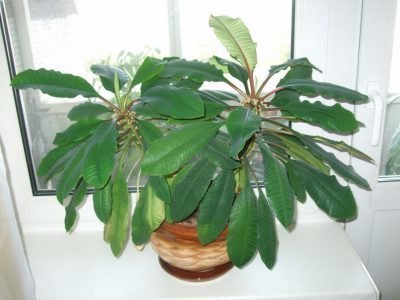

There is also a certain ban on growing a flower, but from a scientific point of view. The plant has a poisonous sap that can cause poisoning and burns. Thorn pricks have bad consequences.
You can keep euphorbia if you follow the safety conditions. This is especially true of the owners in whose house children live.
In order not to manifest the negative energy of the plant, you need to choose the right location.
- Better to place the flower in the hallway. In this case, it will act as a kind of shield against negativity, dangers and adversity. It is worth observing the distance between the flowerpot and the door.
- It is forbidden to choose a bath or toilet as a location. Then the positive energy of the plant will go away with water, and the bad one will remain. This will attract disease to the housing.
- You cannot place a flower in the bedroom, especially if a married couple is planning to conceive a child. He will prevent this.
- During flowering, take the spurge to the living room. During this period, he has the greatest strength. After the plant has faded, return it to its original place.
"Plants-muzhegon"
There are a large number of plants that should not be started in the house from an emotional and psychological point of view. These indoor plants, which bring misfortune to the house, are called "muzhegon plants" from people.
Usually, in addition to the above-described ivy, fall into this category:
- Scindapsus is one of the most popular tropical lianas.It is believed that she not only brings quarrels into the house and is the culprit for divorce, but also “expels” all men from the family, including even sons and grandchildren.
- Cissus - like scindapsus, belongs to the category of plants that have a direct impact on the fact that men leave families. In addition, cissus is considered a real magnet for attracting unhappiness to the family.
- Hibiscus - it is not recommended to have it for unmarried women, as their personal life begins to deteriorate, and the lover may sooner or later leave for another.
- Hoya - it is believed that this plant can not only "drive" a man out of the house, but also squeeze him out of the world.
- Tradescantia - in the house where this plant is located, the marriage may soon collapse.
Can a plant be kept in the house?
It is believed that this plant gets along well with humans and other inhabitants of the house (animals, other plants). However, there are thorny types of milkweed, which, according to Feng Shui, should not be kept in recreation areas and sleeping rooms.
According to popular belief the presence of such a flower in the bedroom will lead to misfortune: discord in family life, a quarrel with a loved one, and if it comes to an unmarried girl or a single guy, then it will be difficult for them to find their real destiny.
Located in the active zones of the house, spurge does not bode well. You don't need to keep this flower in your bedroom, that's all!
Where is it better not to put
There are not many places in the apartment suitable for milkweed. When choosing, you need to be guided by the following rules:
- Cannot be placed in bedrooms or lounges, it will lead to troubles in the family.
- If the spurge is located next to the bathroom or toilet, the positive energy is carried away by the water, and the negative energy remains.
- A plant located near water taps or large containers of water attracts chronic diseases.
- If the flower is nevertheless placed in the bedroom, then it must be removed if the couple is preparing to have a child.
- You can not put in rooms where children sleep or play, spurge will have a bad effect on them.
Ficus
Even in pre-war times, ficus was considered one of the most pronounced symbols of well-being. It was believed that he attracts wealth to the family. That is why even the poorest segments of the population sought to get this plant. However, after the war, the attitude towards him changed dramatically. The opinion began to spread among the people that there were no ficuses in those families where men survived and returned from the war.
Since people called it the "widow plant", for a fairly short time, ill fame was firmly entrenched behind it, and most of the luxurious specimens of these plants were mercilessly destroyed.
Positive qualities of feng shui milkweed
Despite all the difficulties associated with this flower, it can bring a lot of good into the house if certain conditions are met. In the feng shui system, it is sometimes called the palm tree of misfortune. With its energy, a houseplant can attract unpleasant events to the house. This happens again because of the poisonous properties of milkweed and its thorns.
However, negative qualities can be turned into good if you find the right place for the flower pot. Ideal for signs - at the door. There, thorniness will serve as a barrier from evil forces. The flower will not affect the tenants, but those who come to the house with bad thoughts.
Another good place for milkweed is the living room. Feng Shui experts believe that there he will reveal his energy even better and attract abundance. With such a talisman, the tenants of the house will not know failures in any business.
Spurge at home
Euphorbia is a very popular household plant. Since it has a huge number of varieties, not every owner of it knows that he has this green inhabitant at home. You need to deepen your knowledge about him in order to know whether to leave him in your home.The signs associated with the spurge plant should be known to any housewife who loves to decorate her house with greenery.
Like all plants, euphorbia is able to energetically influence a person. According to some sources, any plant with thorns, which are endowed with almost all of its species, should not be placed in the recreation area and bedroom, especially for a married couple, as this contributes to barbs and problems between loved ones and loved ones.
According to other sources, it has life-giving power. This plant promotes peace in the family and positive emotions for all household members. And also he is credited with the ability to give peace and help in relaxation, both moral and physical. It also has a beneficial effect on the musculoskeletal system, strengthening bone tissue and protecting it from the occurrence of various pains. When the plant blooms, then the ability to attract good luck to the house is added to its positive properties.
You should be careful: in the absence of proper care, all positive signs can be replaced by negative ones, and then the inattentive owner, like other household members, will promise misfortune, quarrels and discord. Serious illnesses can be added to this, therefore, the needs of the plant should not be ignored.
Euphorbia white-veined
Euphorbia white-streaked is another species of the plant in question. He brings prosperity and peace of mind to the house, protects from impure forces.
According to feng shui, it is helpful to place a plant near a computer. So the white-tipped spurge will absorb all the negative energy.
Euphorbia cannot be kept at home: myth or reality?
Euphorbia is a potentially dangerous flower, because its juice is one of the strongest toxic substances of plant origin. However, with the right content and precautions, you can grow it at home.
This houseplant is completely safe when handled carefully. If during transplantation, watering and care you wear gloves and try not to damage the leaves or stems, juice poisoning is impossible. When there are small children or pets in the house, keep the pot out of reach to keep out of contact with the poisonous liquid.
There is another reason why many growers refuse milkweed in the house - its prickly. The sign says that any plants with thorns bring discord in relations between opposite sexes, can provoke misfortunes, quarrels and diseases.
However, the negative properties of milkweed make themselves felt only if the pot is in the bedroom or recreation area - in all other rooms, the plant will not do any harm.
Fern
The opinion about the "mystical" fern plant, the flower of which has been sought for a long time on the night of Ivan Kupala, is rather contradictory. So, in some places it is believed that by bringing a fern into the house, you will bring trouble along with it, and as long as the plant is in it, various misfortunes will be attracted to you. However, in other places, it is believed that the fern, on the contrary, protects the family from the evil that other people do, and all evil spirits. It is believed that if a fern dries up unexpectedly, then it has taken on the damage directed against the homeowner.
Ivy
In the Middle Ages in Greece and Rome, ivy was not only a symbol of devotion, but also acted as one of the most common talismans for young girls. It was believed that it symbolizes not only the possibility of a successful marriage, but also allows the owner to maintain youth and attractiveness for a long time. To do this, it was enough just to wear a twig of ivy on the chest.
As for the present, in the East, they believe that it increases the life energy of the owner, prolonging his life.At the same time, in the post-Soviet territories, there is an opinion that ordinary ivy, which is massively distributed in the southern regions, attracts misfortune to the house. In addition, it is not recommended to put it in the house of the newlyweds, as it can cause discord and quarrels in families, as a result of which men leave their families.
It is noteworthy that ivy is not recommended to be started by followers of the Feng Shui philosophy, who claim that this plant, like most climbing plants, is capable of taking the energy of health and love from home.

